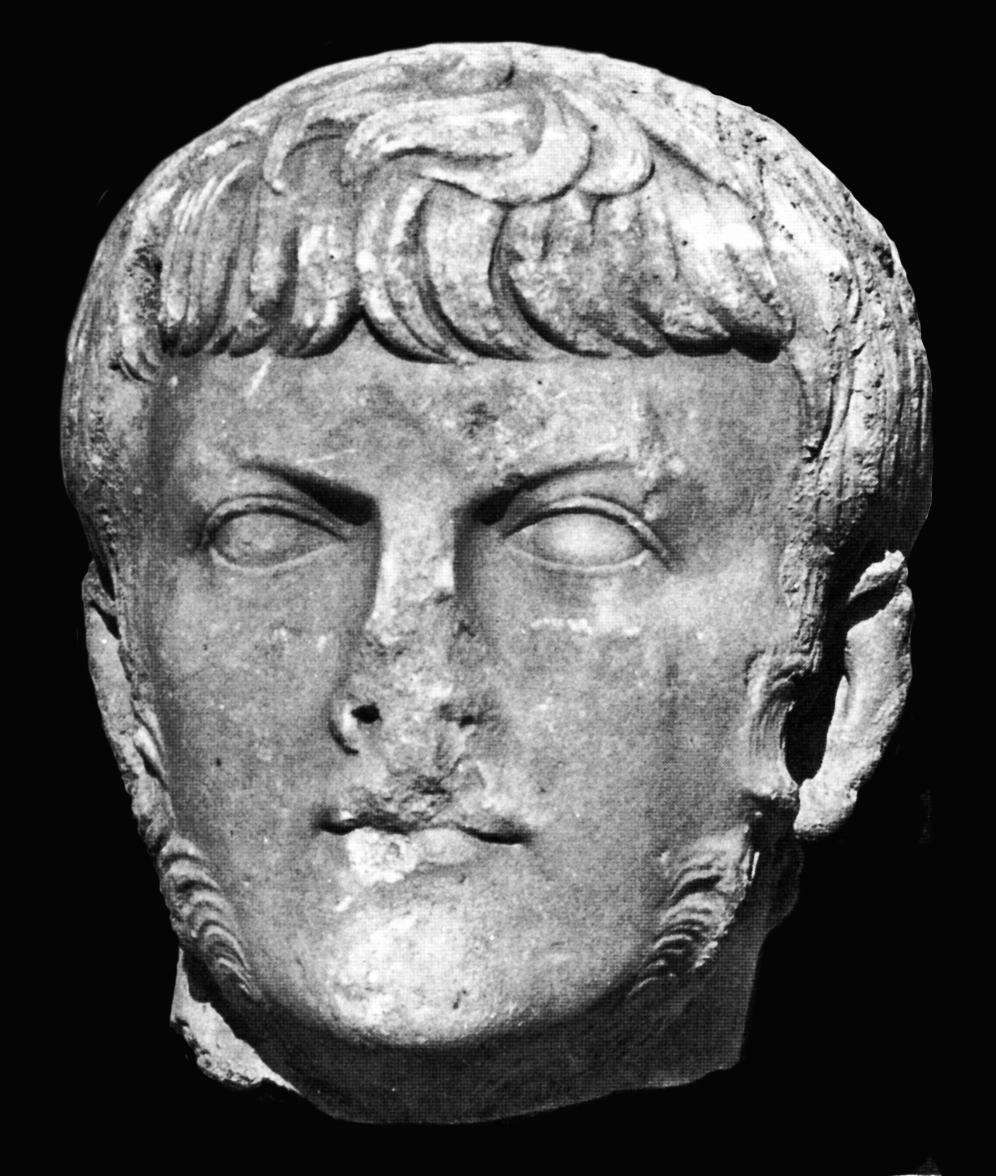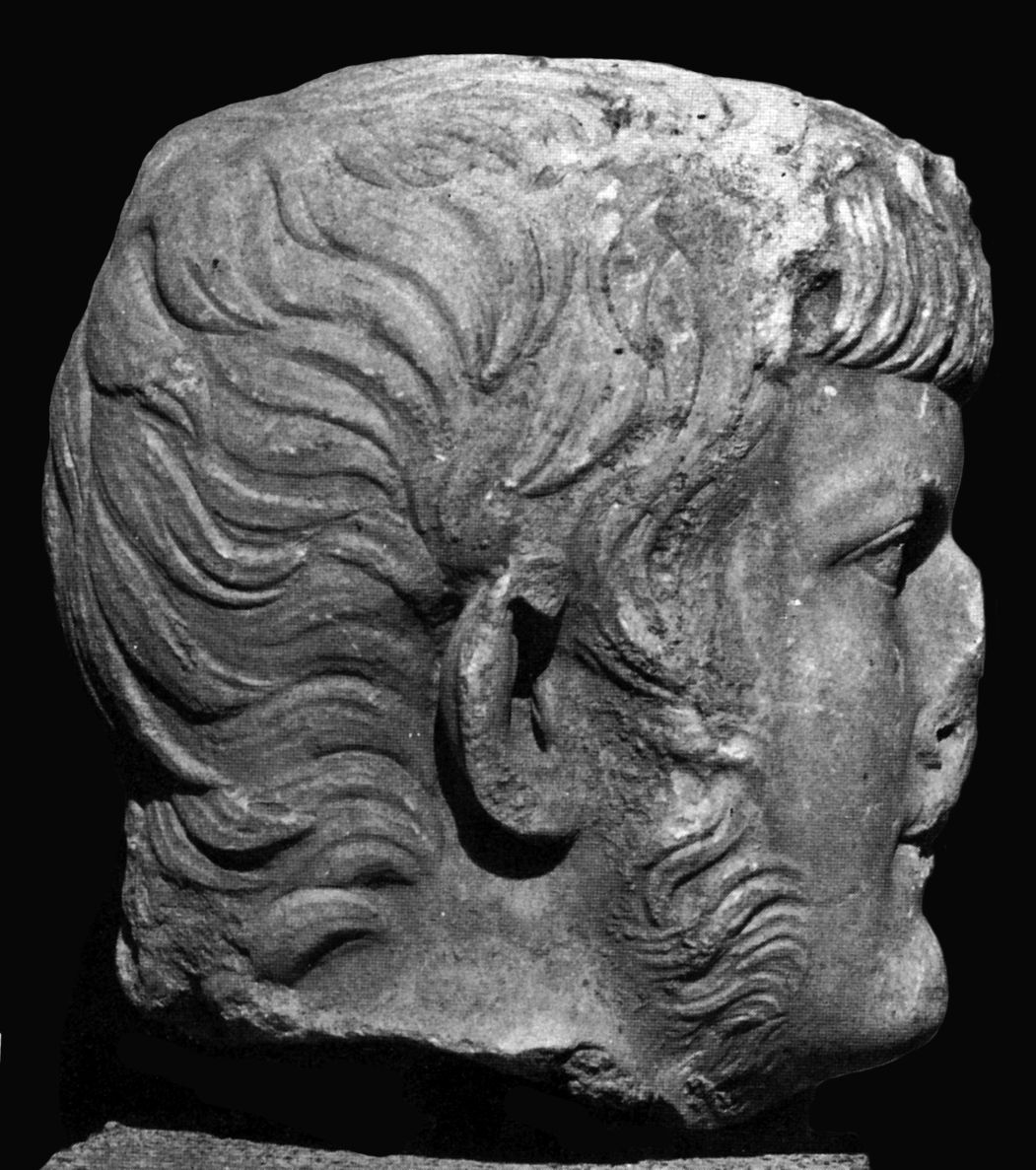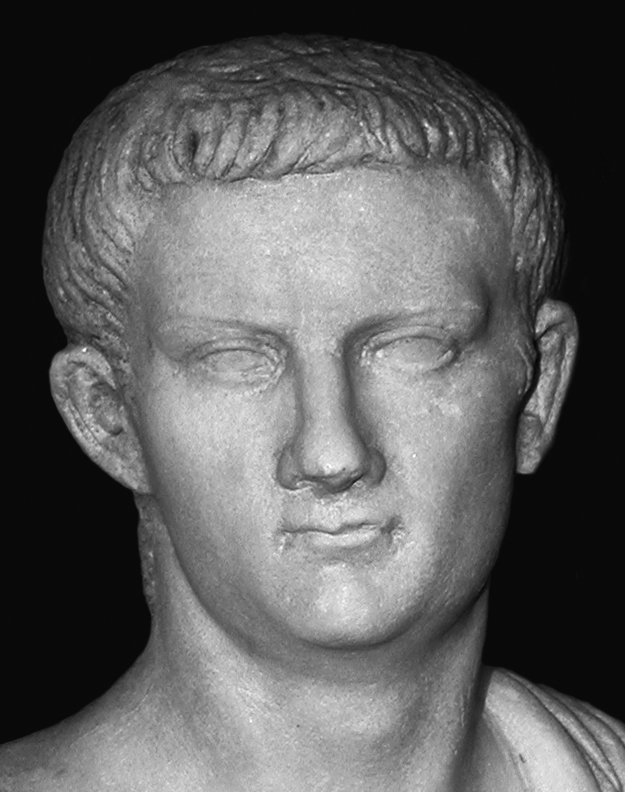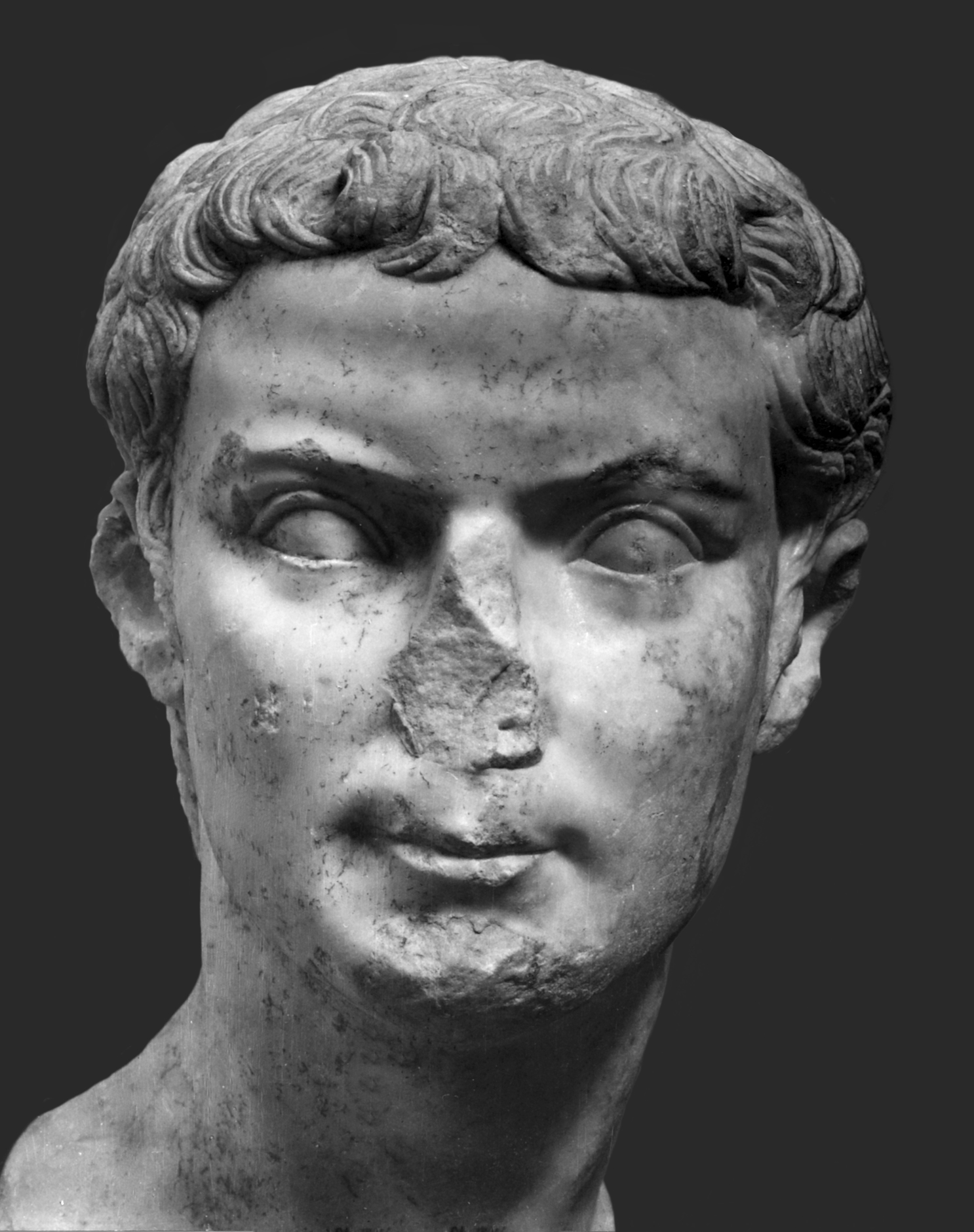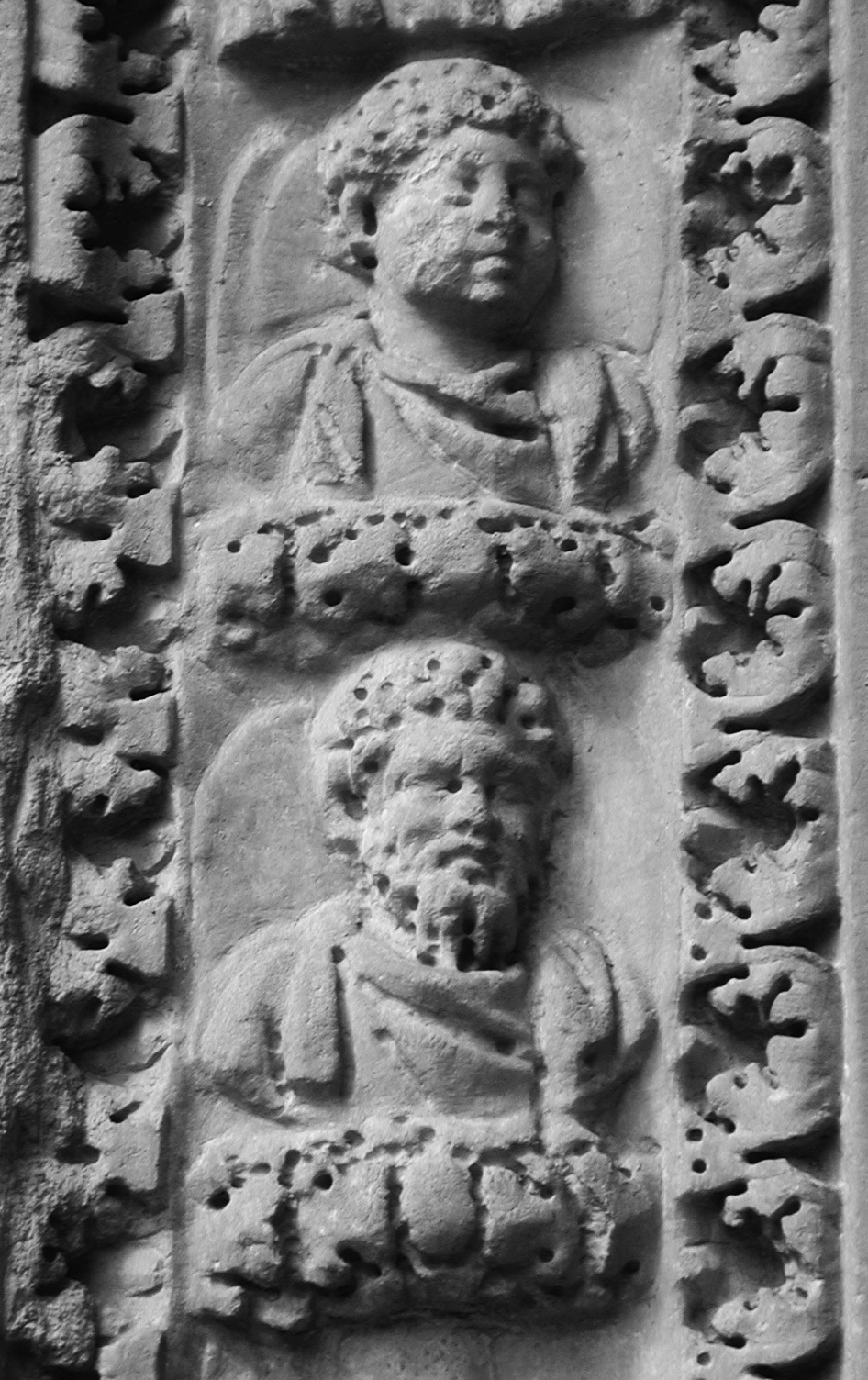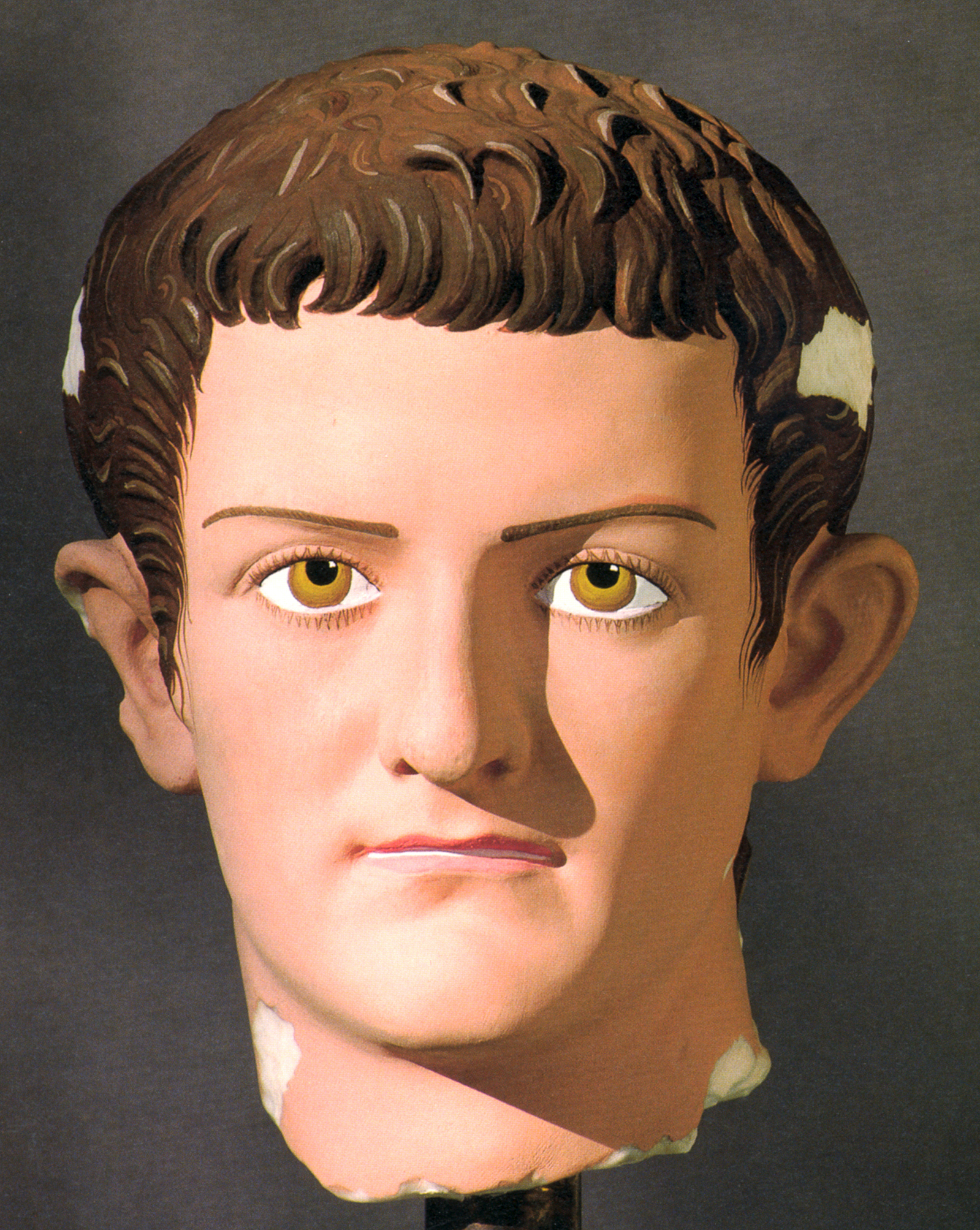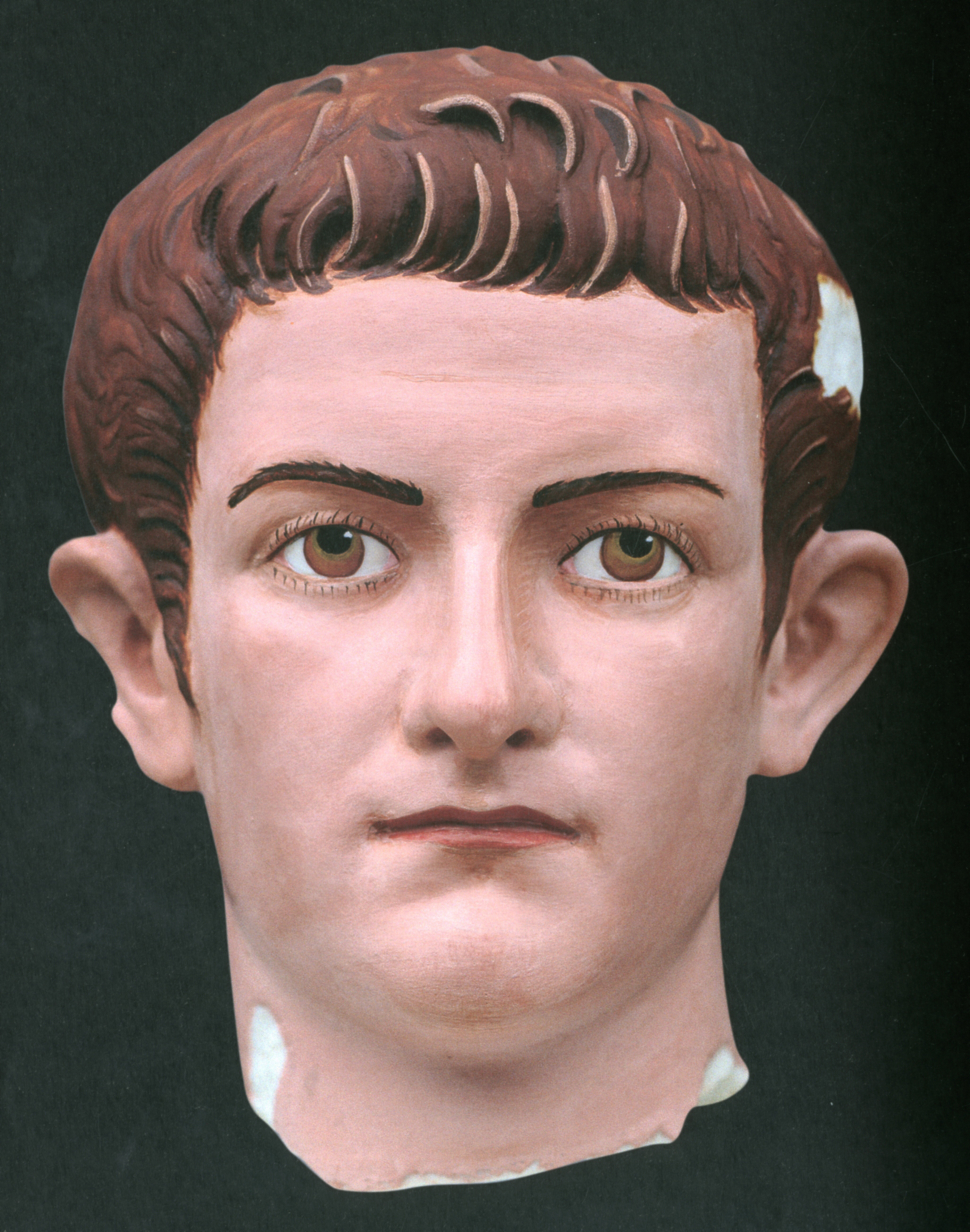In Memoriam John D. MacIsaac* |
The Image of Caligula: Myth and Reality |
John Pollini |
As in the case of several of Rome's other so-called "bad emperors," much nonsense has been written about Caligula and his supposed insanity, not to mention the claim that he believed that he was a "living god."[1] These views have been expressed not only by ancient detractors of the emperor but also by modern biographers and writers of historical fiction; they crop up in the popular press, film, and television programs, which have a strong tendency to sensationalize stories for a public that enjoys hearing about the excesses and eventual comeuppance of the "rich and infamous." This phenomenon was as true in antiquity as it is today and is perhaps best exemplified in the writings of the Roman biographer Suetonius, whose biographies of the first twelve emperors might be regarded as antiquity's version of the tabloid press. For Suetonius and other ancient historians (especially ancient biographers influenced by epideictic rhetoric), the value of writing history and biography often had more to do with teaching moral lessons and, in the case of the Caesars, establishing what constituted "good" or "bad" leadership rather than investigating, let alone arriving at, historical truth or reality.
Perhaps more shocking than the writings of ancient biographers are the attempts by modern scientists and medical practitioners to diagnose the cause and nature of the insanity attributed to Caligula, as though his being clinically insane was an indisputable historical fact and not an ancient fiction created by his detractors or by those seeking an explanation for his extravagant behavior. In the same vein, even some art historians have claimed to be able to detect a touch of insanity in ancient portraits of the emperor, such as the famous marble head of Caligula in the Ny Carlsberg Glyptotek in Copenhagen, because of the odd look created by the remains of paint in only one of his eyes (fig. 1).
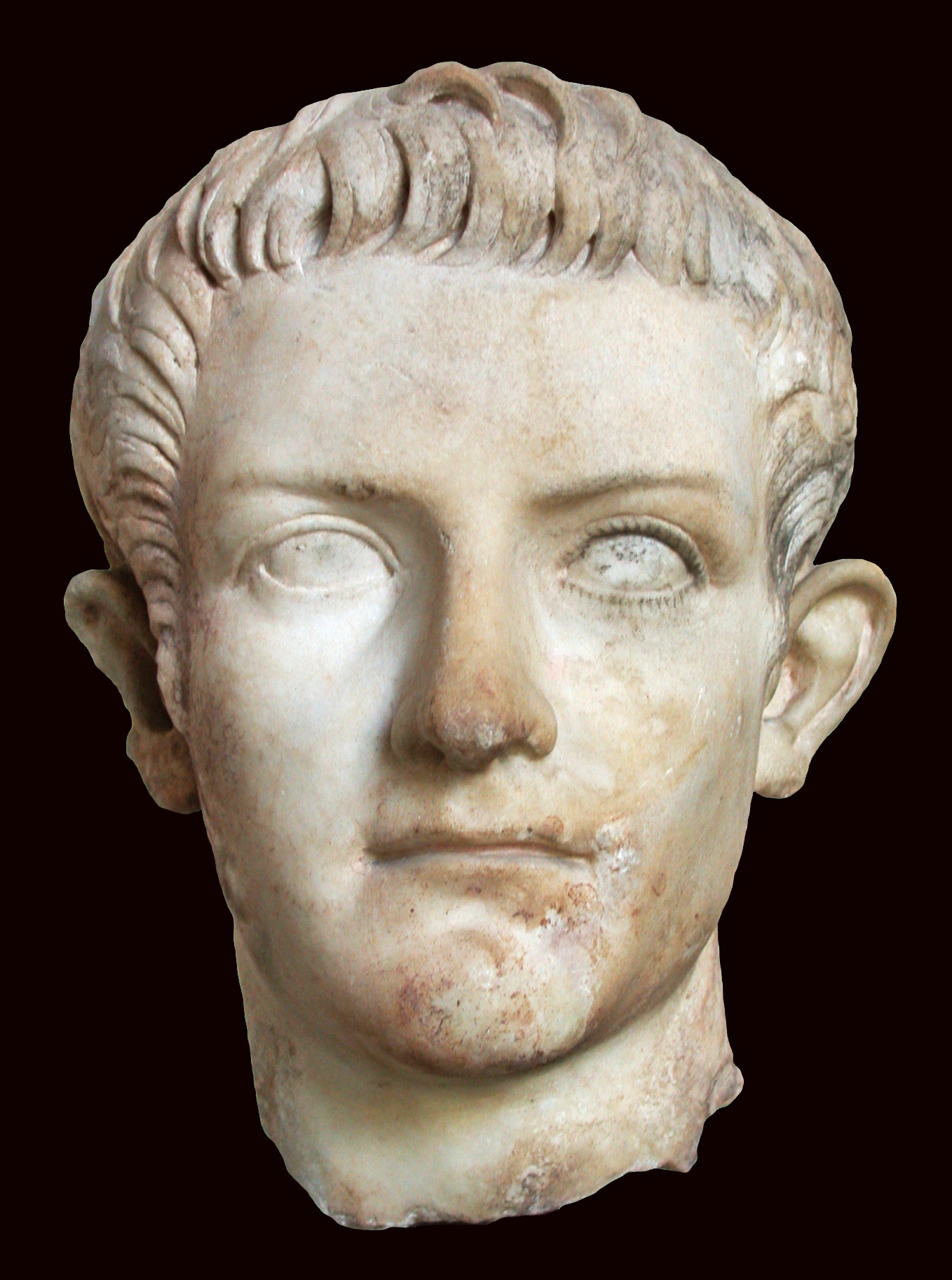
|
| Fig. 1 Portrait of Caligula, Ny Carlsberg Glyptotek, Copenhagen: Photo author |
As related to me by a former Curator of Classical Antiquities at the Ny Carlsberg Glyptotek, museum docents will often say to Danish school children when viewing this portrait of Caligula, "Doesn't he look crazy?" Although many of the stories told about Caligula that are supposed to prove his insanity are wonderfully entertaining and titillating, they have, in my view, little to do with the historical reality of his mental stability or lack thereof.[2] Unlike most authors of this ancient and modern pulp fiction, Anthony Barrett tried, and, I believe, largely succeeded in, separating fact from fiction in his excellent book Caligula: The Corruption of Power, first published in 1989.[3] In this endeavor, other historians, such as Sam Wilkinson and Aloys Winterling, have followed Barrett in recent years.[4] Caligula's lack of preparation for the power that was thrust upon him, coupled with serious character flaws, spelled disaster for those with whom he needed to cooperate in order to govern effectively, a failure that ultimately cost him his life.
Those who have studied Julio-Claudian portraiture know well that there are many problems in identifying the various members of this complex imperial family, whose portraits show a strong resemblance to one another not only physiognomically but also with respect to their iconographic hairstyles. Perhaps one of relatively few secure image of Caligula before he became Princeps is his representation on the magnificent Grand Camée de France in the Bibliotheque Nationale in Paris (fig. 2a-b).[5]
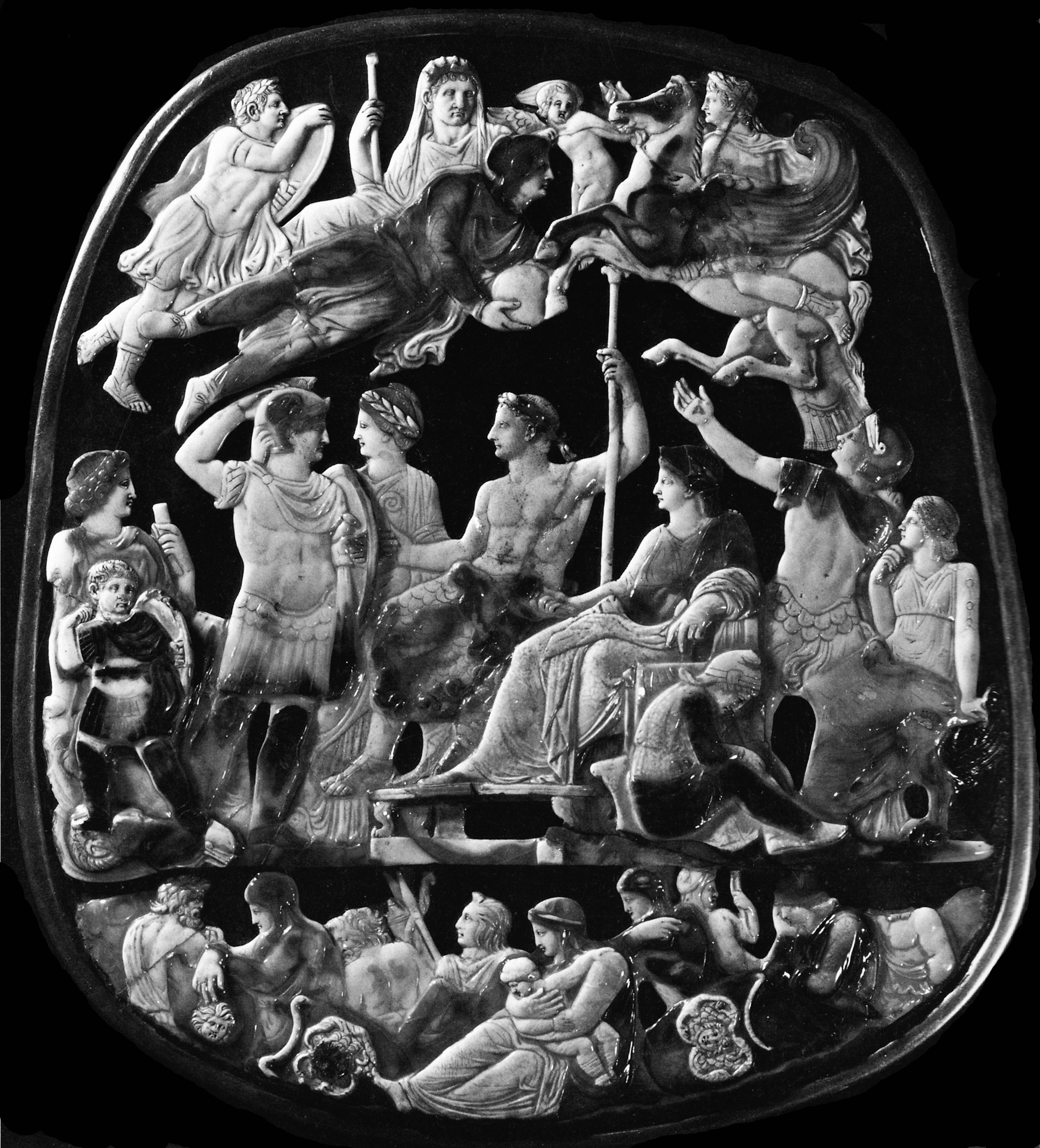 |
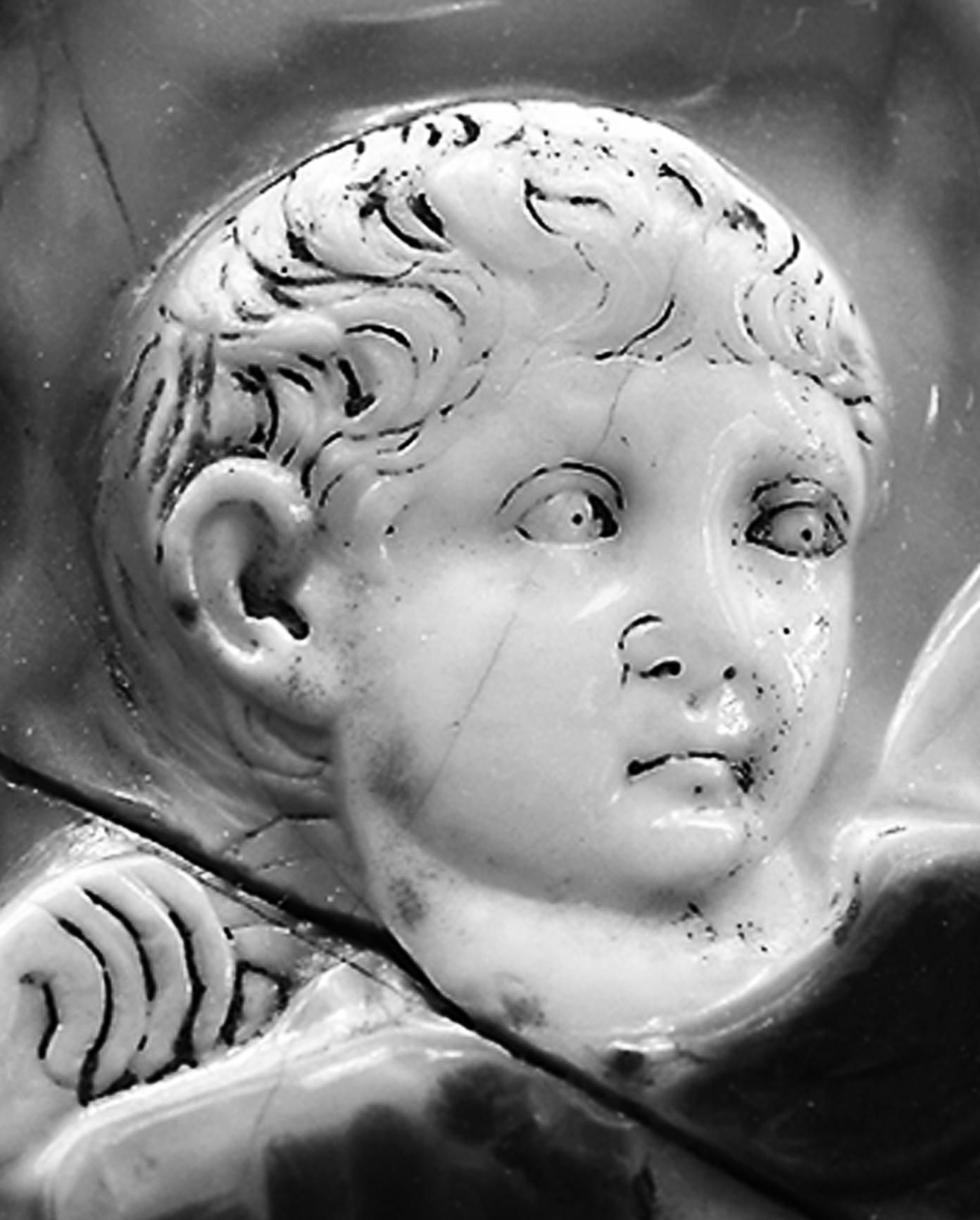 |
| Fig. 2a Grand Camée de France, Bibliotheque Nationale, Paris: After Megow (1987) pl. 33.5 | Fig. 2b Detail of figure of Caligula: After Megow (1987) pl. 33.5 |
Here Caligula appears as a boy in the presence of an enthroned Tiberius and Livia and other members of the Julio-Claudian house, including his then deceased father, Germanicus, and two older brothers, Nero Iulius and Drusus Iulius. The depiction of Caligula wearing armor and military boots reflects the story of how he received his nickname "Little Boot" from his father's soldiers because he was dressed like a common soldier wearing little military booties, or caligulae, the Latin diminutive form of caligae (Suet. Calig. 9). In many of Caligula's images, including his boyhood representation on the Grand Camée de France (fig. 2b), his hair forks over his forehead, a feature shared with portraits of Tiberius as Princeps (e.g., fig. 3)[6] and of his very popular father Germanicus (e.g. fig. 4),[7] not to mention with his two older brothers, Nero Iulius (fig. 5a-b)[8] and Drusus Iulius (fig. 6a-b).[9]
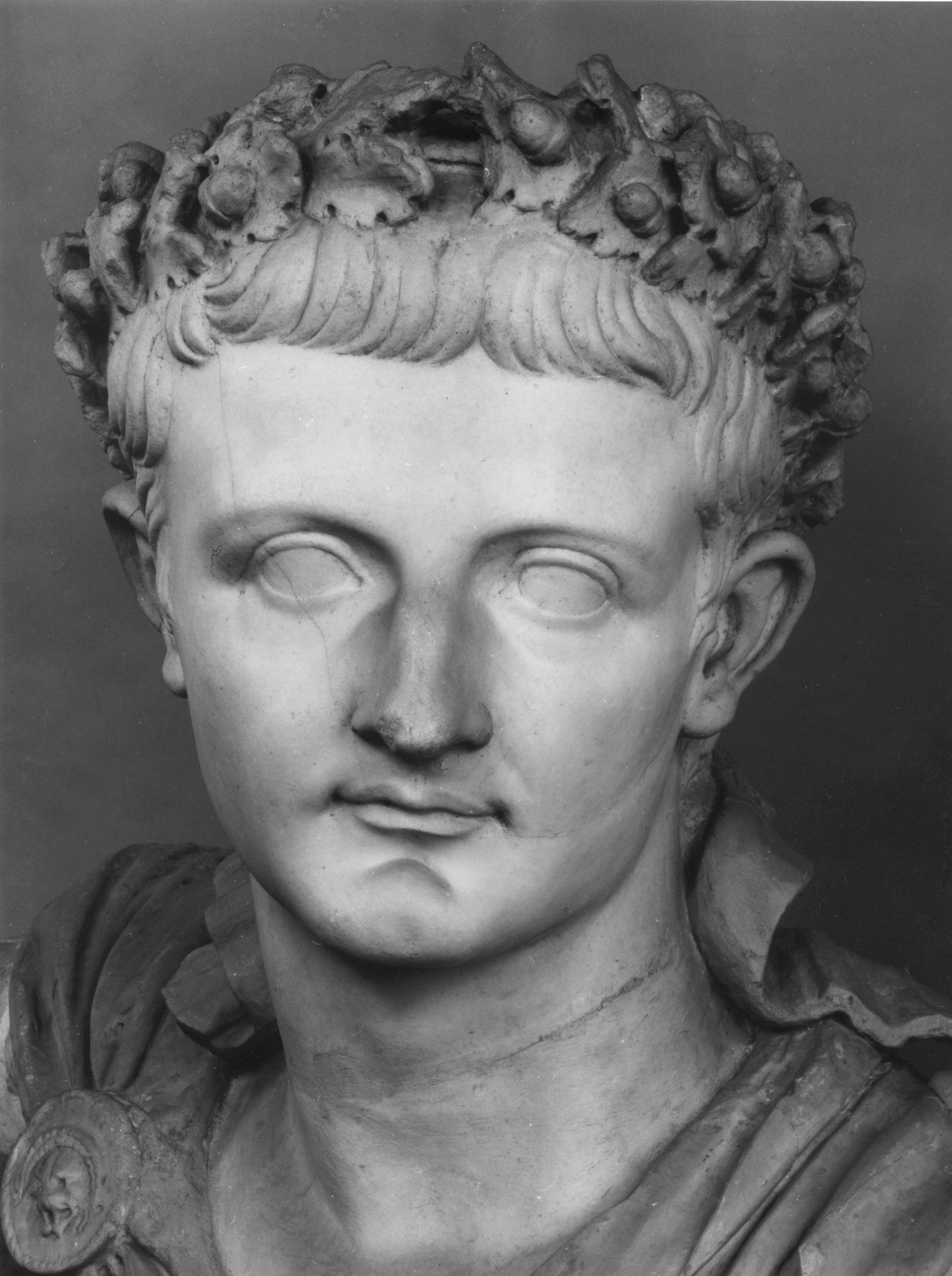 |
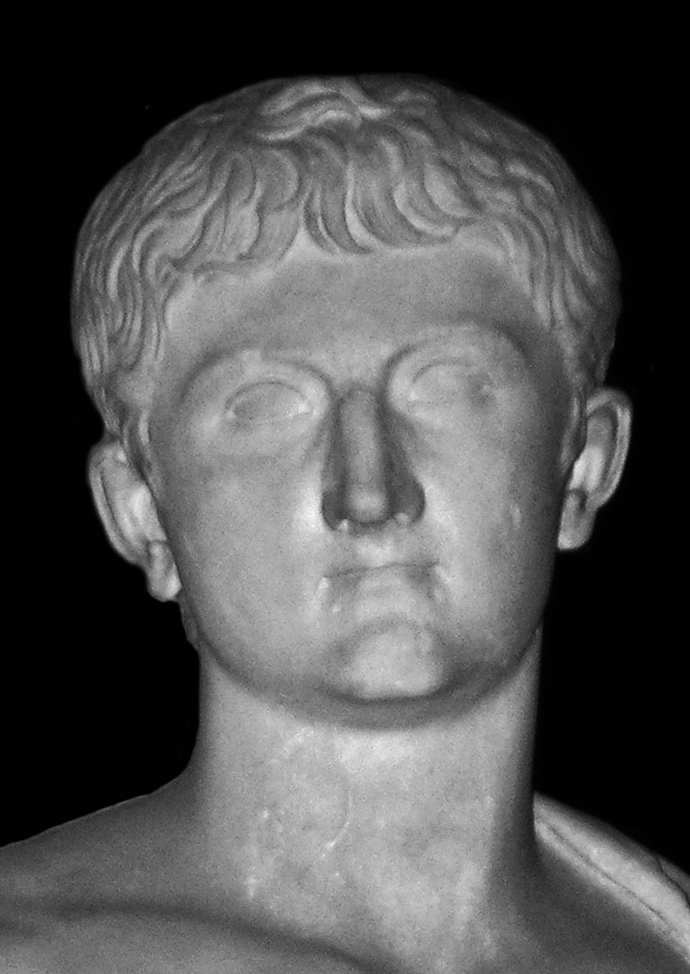 |
| Fig. 3 Portrait of Tiberius, Chiaramonti Museum, Vatican: After Pollini (2005) pl. 12.5 | Fig. 4 Portrait of Germanicus, Louvre, Paris: Photo author |
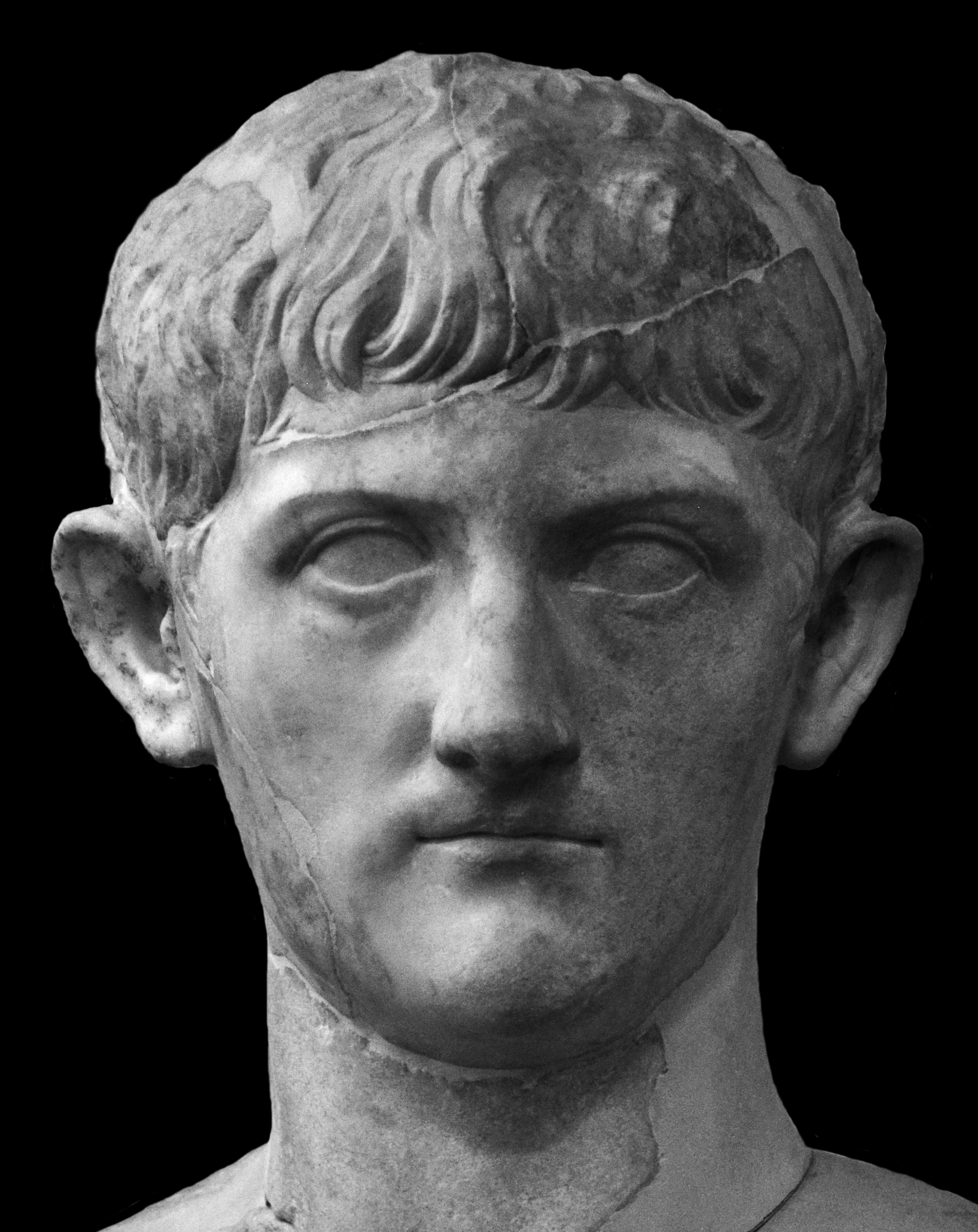
|
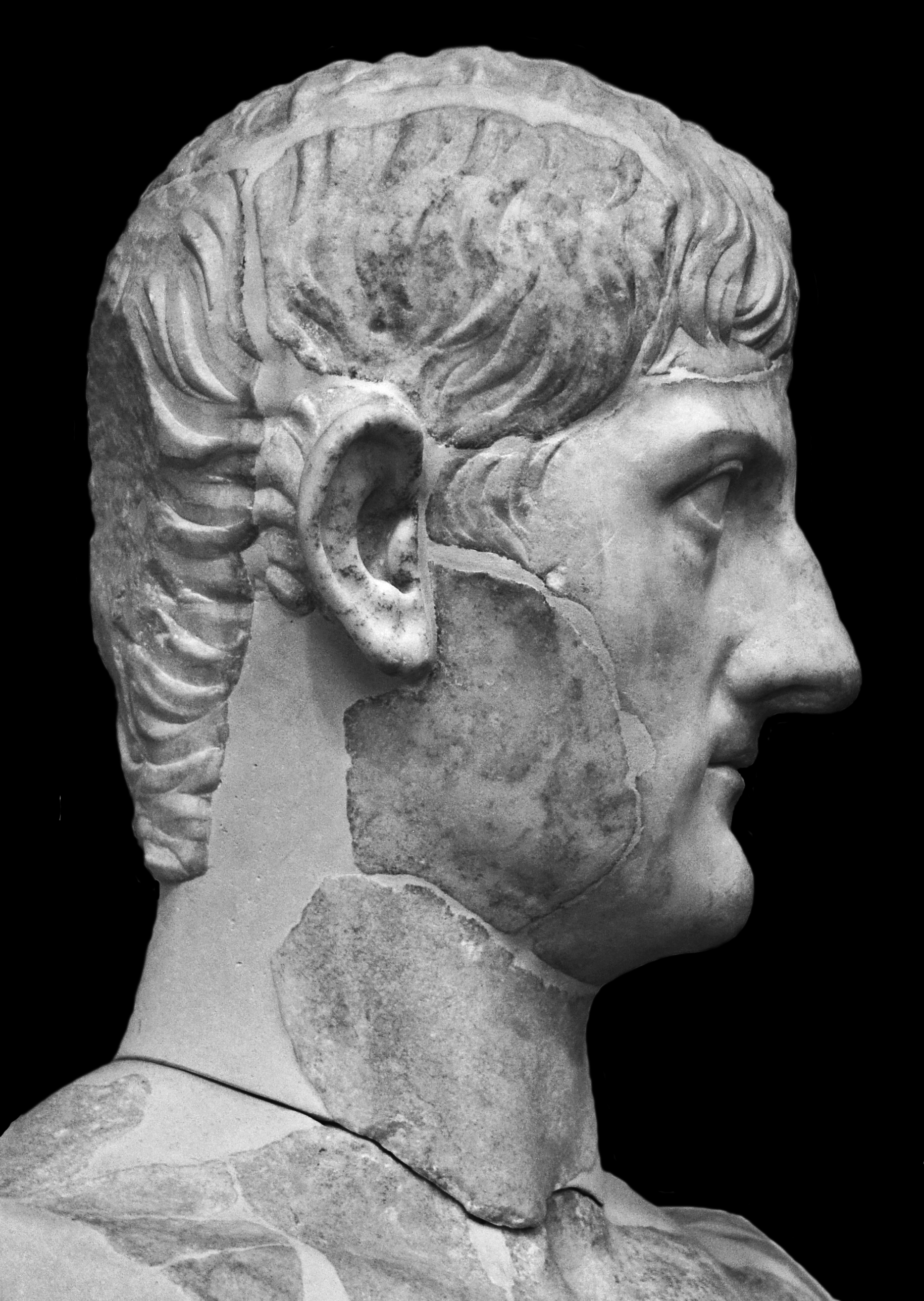
|
| Fig. 6a Portrait of Drusus Iulius (Germanici f.) from Rusellae, Museo Archeologico, Grosseto: Photo author |
Fig. 6b Same as fig. 6a: Photo author |
Even in Caligula's later portraits, after he succeeded Tiberius as Princeps, it is sometimes difficult to identify Caligula solely on the basis of facial features since there is at times considerable diversity in his imagery not only in Rome (e.g., fig. 7),[10] but especially in the provinces of the Empire (e.g. a portrait from Mustis in North Africa—modern Tunisia, fig. 8).[11]
For this reason, Caligula's iconographic hairstyle, especially with regard to the arrangement of the fringe of locks over the forehead, is of great importance in identifying his portraits. Although the configuration of locks is by no means identical in all respects in images of a given portrait type, hairstyles were generally far easier to carve in marble than facial features (even by less talented sculptors), and they therefore provide an important index for identifying portraits.
My focus here is on the "image" of Caligula as transmitted to us by not only the ancient visual evidence, consisting largely of sculpture and coinage, but also the literary sources representing the views of his detractors. Although sculptural portraits of Caligula have come down to us, none has been found in association with his inscribed name. Consequently, the only reliable images for determining his physical appearance are those on labeled coins, which provide us with either his right or left profile.[12] These numismatic profile views can be compared with sculptural portraits-in-the-round to establish the identity of the imperial personage represented.[13] Though representations of Caligula in the form of portraits must also certainly have existed, none has survived from antiquity.[14]
Whether numismatic or sculptural, the extant portraits of Caligula and other members of the imperial family ultimately reflect, to some degree, a three-dimensional "Urbild," or prototype, for which the individual presumably sat.[15] These prototypes, which were probably first produced in clay, no longer survive, but they would have been used for terracotta or plaster models that would presumably have been made available by imperial agents for distribution throughout the Empire, both through military channels and via the "art market."[16] However, there is no surviving material evidence for these putative plaster or terracotta casts of Roman portraits.[17] Other types of models may also have been distributed via the art market. One possibility not considered in the past is the dissemination of painted wax face-mask models, though we have no direct evidence for this either.[18]
Many of the portraits produced in the provinces for civic contexts and municipal or colonial worship did not closely follow the imagery of Roman state models, which reflected the official ideology of the principate. Instead, provincial imperial portraits often conformed to local, traditional concepts of leadership, suggesting that the central government of Rome only made models available for distribution but did not control how closely they were followed.[19] Local social pressures would nevertheless have assured that the imperial image was both dignified and appropriately displayed. In other areas of production, there is reason to believe that the central government, through its agents, did play a direct role in disseminating imperial images, including determining how they would look (as in the case of state coinage, which was under the direct control of the Princeps).[20] The involvement of imperial agents would likely have also been necessary, for example, when there was a need to make imperial images available rather quickly to the military throughout the Empire.[21] These images were undoubtedly required in military camps in administering the loyalty oath (sacramentum) to a new Princeps and/or, when necessary, to his officially designated successor.[22]
The imperial image before which soldiers usually swore their oath -- at least initially to a new Princeps -- probably took the form of a small bronze imago clipeata ("shield portrait") or some sort of small bust applique like that attached to the military standard (signum) carried in battle, or it may even have been a small bust affixed to the top of a plain pole as a finial. Such standards and poles were also used in parades and kept in the shrine (sacellum or aedes) of a military camp along with portrait statues of the Princeps (and his designated successor), images of the gods, and other military insignia.[23] Thus, represented on the Severan Arch of the Argentarii in Rome is a Praetorian standard with attached small busts of Septimius Severus (below) and his young son and designated successor Caracalla (above)(fig. 9a-b).[24]
An actual small bronze bust of Caligula with battered facial features, which had been thrown into the Tiber (fig. 10), may have once served as a bust-decoration for an actual military standard, perhaps even (given its provenance) of the Praetorian Guard in Rome, or it may have been used as a finial-ornament affixed to the top of a pole.[25]
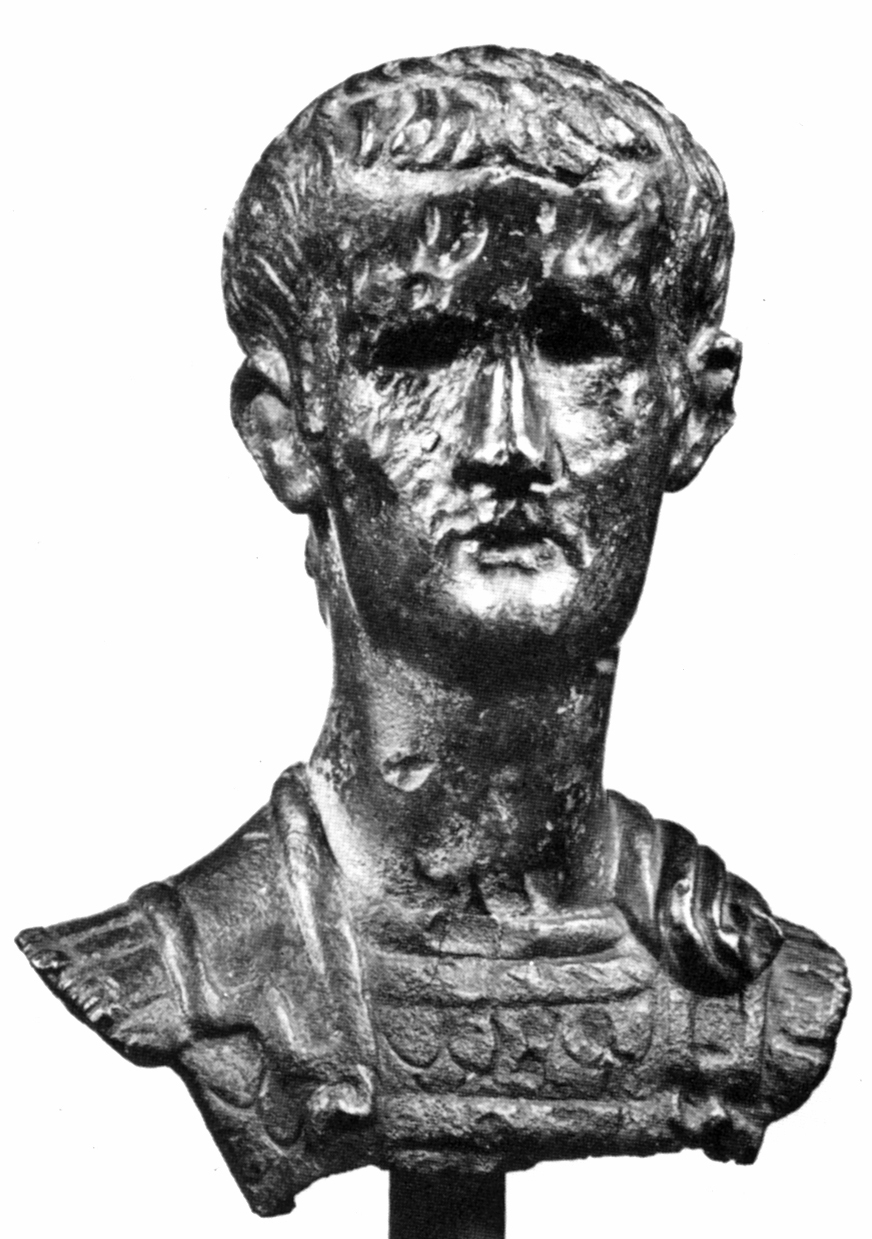
|
| Fig. 10 Bronze bust of Caligula with battered face, Swiss Private Collection: After Boschung (1989) pl. 27.1 |
A passage in Tertullian (Apol. 16.8) indicates that soldiers swore by military standards: religio Romanorum tota castrensis signa veneratur, signa iurat, signa omnibus deis praeponit ("the religion of the Romans, entirely [a religion] of the camp, venerates the standards, swears oaths by them, and places them before all the gods"). Such oath swearing would be understandable in view of the decoration of standards with imperial images. Like coins, small bronze imagines could be reproduced in great numbers and quickly distributed to the armies throughout the Empire. This practice may be implied in a passage in Tacitus' Annales (Ann. 1.3) in which Augustus' adopted son and designated successor, Tiberius, who had tribunician power and imperium over the provinces equal to that of Augustus, was shown (i.e., in effigy) to all the armies: filius [Tiberius], collega imperii, consors tribuniciae potestatis adsumitur omnes per exercitus ostentatur. Needless to say, Tiberius could not have personally gone around to all the armies throughout the Empire after being officially designated Augustus' successor, so the passage must refer to his image in one form or another, which could have been easily and quickly distributed to them.
Although not true portraits, small idealized representations of Augustus' Genius were given by Augustus along with statuettes of his Lares to all the vici ("districts") of the city of Rome, as we know from Ovid (Fasti 5.145-146): Mille lares geniumque ducis, qui tradidit illos,/ Urbs habet, et vici numina trina colunt ("The city has a thousand Lares and the Genius of the leader [Augustus], who handed them over, and the vici worship three divinities (numina) [i.e., the two Lares Augusti and the Genius Augusti of each vicus]"). The need to distribute rapidly so many statuettes after Augustus' reinstitution of the Lares cult in Rome suggests that they, too, would have been mass-produced in bronze.[26] Moreover, whether small bronze representations of the new Princeps for the armies or figures of Augustus' Genius for the many vici of the city of Rome, the dissemination of images in a relatively short period of time would have required organization, suggesting, as in the military, the direct role of the central government and its agents. This would also have been true in the case of the distribution of life-size models in plaster or terracotta to meet the great demand of cities and municipalities to honor a new Princeps by setting up his image in many different contexts. Therefore, the degree to which the central government and its agents were involved in the dissemination of the imperial image in the early Empire must have depended on for whom and for what purpose the image was destined.
The portraits of Caligula that have come down to us -- regardless of the medium of the models upon which they were based --– reflect, to varying degrees, a given lost prototype and so are designated replicas, variants, free adaptations, or transformations based on how closely each extant image resembles its presumed Urbild.[27] Needless to say, such a taxonomic, or typological system, can be subjective. Of the thousands of images of Caligula in all media that must have once existed during his principate, only a small fraction -- mostly numismatic and sculptural portraits -- now survive. Among the fifty or so non-recut portraits of Caligula that have been recognized (aside from those on coins), there are a few small bronze busts, several cameos, and a couple of glass-paste medallions.[28] A good number of Caligula's portraits were also recut into images of his imperial predecessors or successors, sometimes in a more obvious fashion than others.[29] The re-cutting of a portrait of one imperial personage into an image of another, usually, but not exclusively, as a result of some sort of memoria damnata, is a well-known phenomenon in Roman portraiture that is treated by Eric Varner in this collection of essays.[30]
One of the reasons that there is some diversity in facial features, as well as in given iconographic hairstyles, is that marble or other types of stone images were rarely copied exactly in Roman antiquity.[31] Variation in imagery can also be ascribed to (1) the competence of the sculptor, (2) his interest -- or lack thereof -- in reproducing faithfully all the details of an original model, (3) his adherence to local workshop practices and traditions, and (4) any need to adapt an image reflecting the official ideology of Rome to one reflecting local or regional notions of how a leader should appear.[32] The diversity among the resulting sculptural images of a given imperial personage that we find throughout the Empire also confirms that the government of Rome did not require rigid adherence to a given prototype, although a great many artists were capable of producing close copies. Diversity, too, is in keeping with Roman custom, which respected the established cultural traditions of the many peoples who made up the Empire, especially if they showed the same respect for the traditions and values of Rome. Over the course of the life of a given Princeps, there were often several principal portrait types that might be created. Sometimes new types were produced with some slight change in the facial features because of idealizing tendencies in portraiture, but more often the changes can be found in the arrangement of the hair locks, especially the configuration of the fringe of locks over the forehead. The motivation for the creation of a new official iconographic hairstyle was generally to celebrate some important event or situation in the life of a prominent individual.[33]
In the principal study of Caligula's portraiture, Die Bildnisse des Caligula, published in 1989, Dietrich Boschung concluded that during Caligula's short-lived principate of just under four years, only one official chief portrait type, or "Haupttypus," was produced. According to Boschung, the majority of Caligula's surviving sculptural images, including several variants and cameos, reflect only this single principal type.[34] In addition to his Haupttypus, Boschung believed that there once existed a secondary type, which he termed a "Nebentypus," created after the "Haupttypus." According to Boschung, the Nebentypus can be further divided into two groups, the first made up of three marble replicas, one small bronze bust, one cameo, and two glass-paste medallions[35], while the second group consists of just two marble portraits.[36] Because of the subjective nature of this approach to sculpture, portrait specialists are not always in agreement as to what constitutes a given portrait type or how great a divergence there needs to be to justify the designation of another type. In typological portrait studies, a given type is determined by a great degree of correspondence of details among several extant heads of high quality which were generally produced in the leading workshops in and around Rome. These ateliers presumably followed more closely than provincial workshops the imperially commissioned prototype in terracotta or plaster, which reflected the official ideological concept of how a Roman leader should appear to the citizenry.[37]
By comparing all existing sculptural images of Caligula, Boschung concluded that five high quality extant portraits constitute the core group of Caligula's "Haupttypus." One of the best representatives of his Haupttypus is a portrait in Schloss Fasanerie near Fulda, Germany (fig. 11a-b).[38]
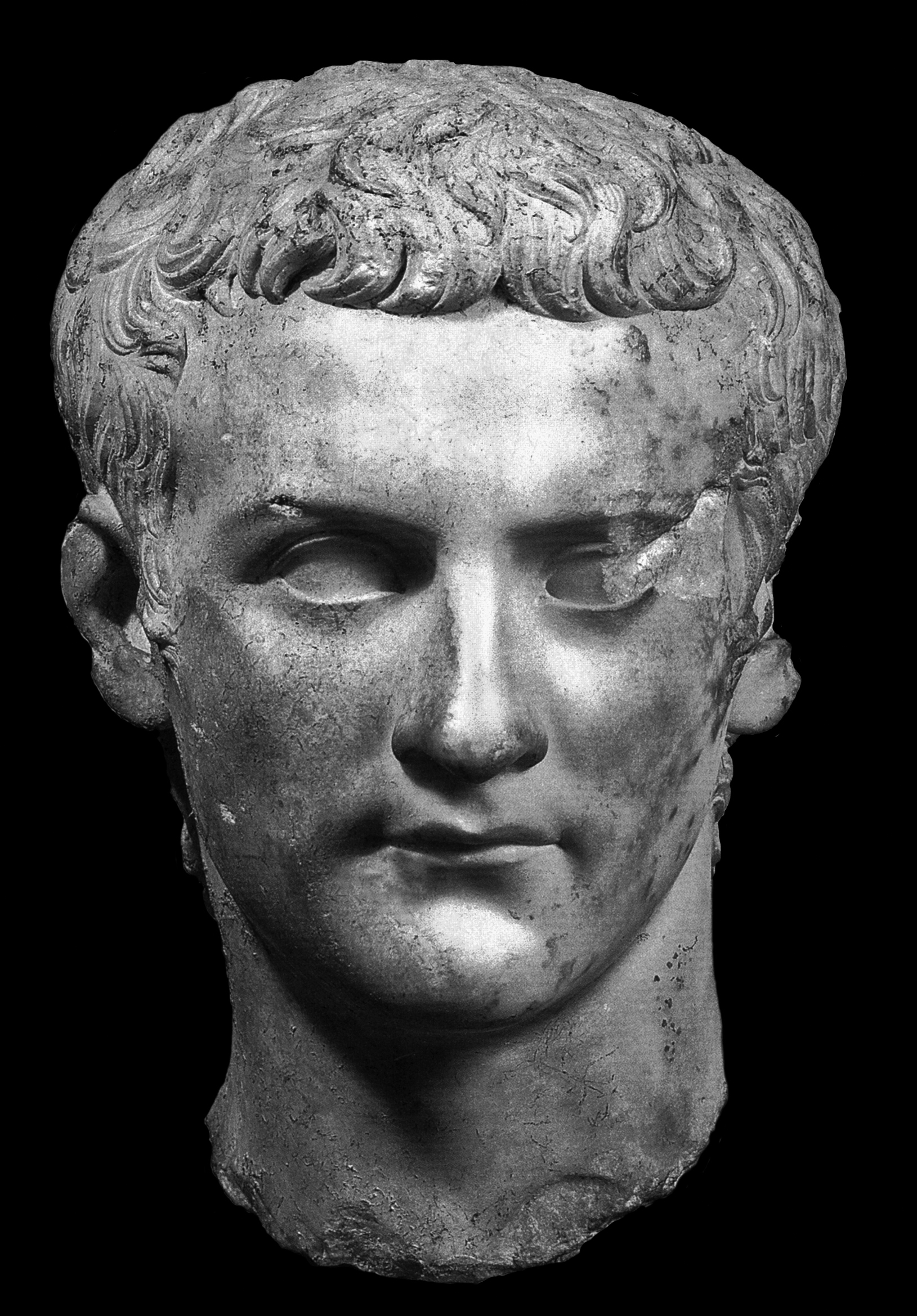 |
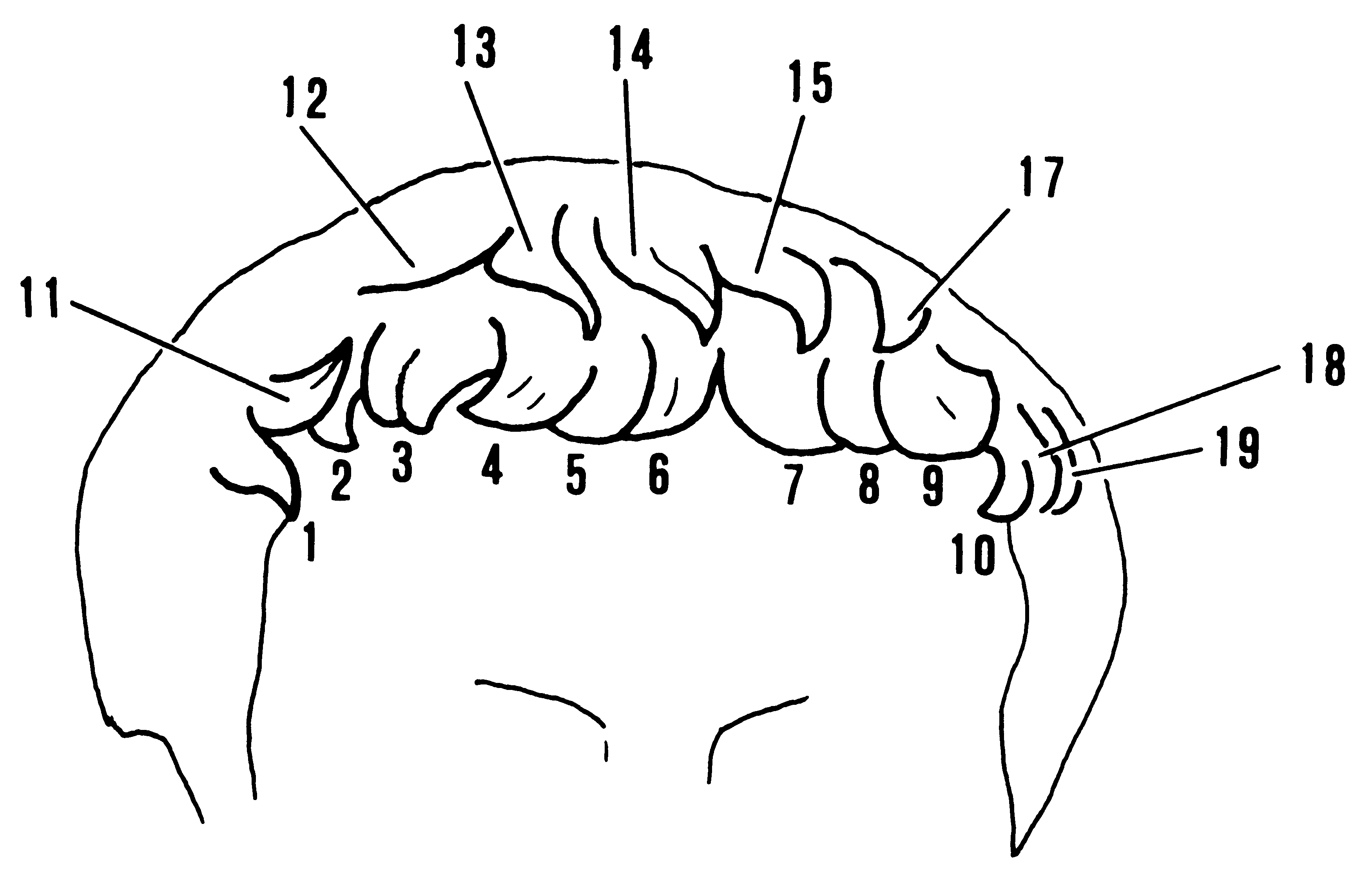 |
| Fig. 11a Head of Caligula in Schloss Fasanerie (near Fulda), Germany: After Hoff and Dobler, edd. (2005) 29 | Fig. 11b Hair scheme of fig. 11a: After Boschung (1989) 33, Skizze 5 |
This head, which probably came from Rome,[39] possesses certain facial characteristics that are commonly shared with other members of the Julio-Claudian house. Among these features, the most dominant family traits are the wide forehead and the bird-like mouth with a recessive lower lip. This core group of portraits gives us an idea of what the now lost prototype in Rome looked like. It should also be pointed out that the head of the magnificent, high quality Caligula statue in Richmond's Virginia Museum of Fine Arts, presumably from an imperial shrine of the Sodales Augustales Claudiales at Bovillae (click here for images of the VMFA Caligula),[40] constitutes, according to Boschung, part of a secondary group of five portraits closely associated with one another but somewhat less closely related to the Schloss Fasanerie core group.[41] The facial features of the Richmond and Schloss Fasanerie portraits are fairly close, though the shape of the face of the Schloss Fasanerie head tends to be somewhat more elongated, and there are minor differences in the hairstyles of the two portraits.
As for Boschung's "Nebentypus," or secondary type, there are substantial differences from the principal type, especially in the configuration of the fringe of locks over the forehead (the "Nebentypus" lacks a major forking of the hair locks towards the middle of the forehead exhibited by the "Haupttypus"). Instead, in the "Nebentypus," there is a fringe of distinctive comma-shaped locks brushed to the right side across the middle of the forehead with a forking of the locks usually to the far left side of the forehead. This iconographic lock configuration is to be found in a magnificent high quality head in the Ny Carlsberg Glyptotek (fig. 12a-b)[42] and in other portraits of this type, including those in the Yale University Art Gallery in New Haven (fig. 13a),[43] the Museo Archeologico dei Campi Flegrei in Baia (fig. 14a-b [Skizze 31]),[44] and the Museo Civico in Fossombrone (fig. 15a-b).[45]
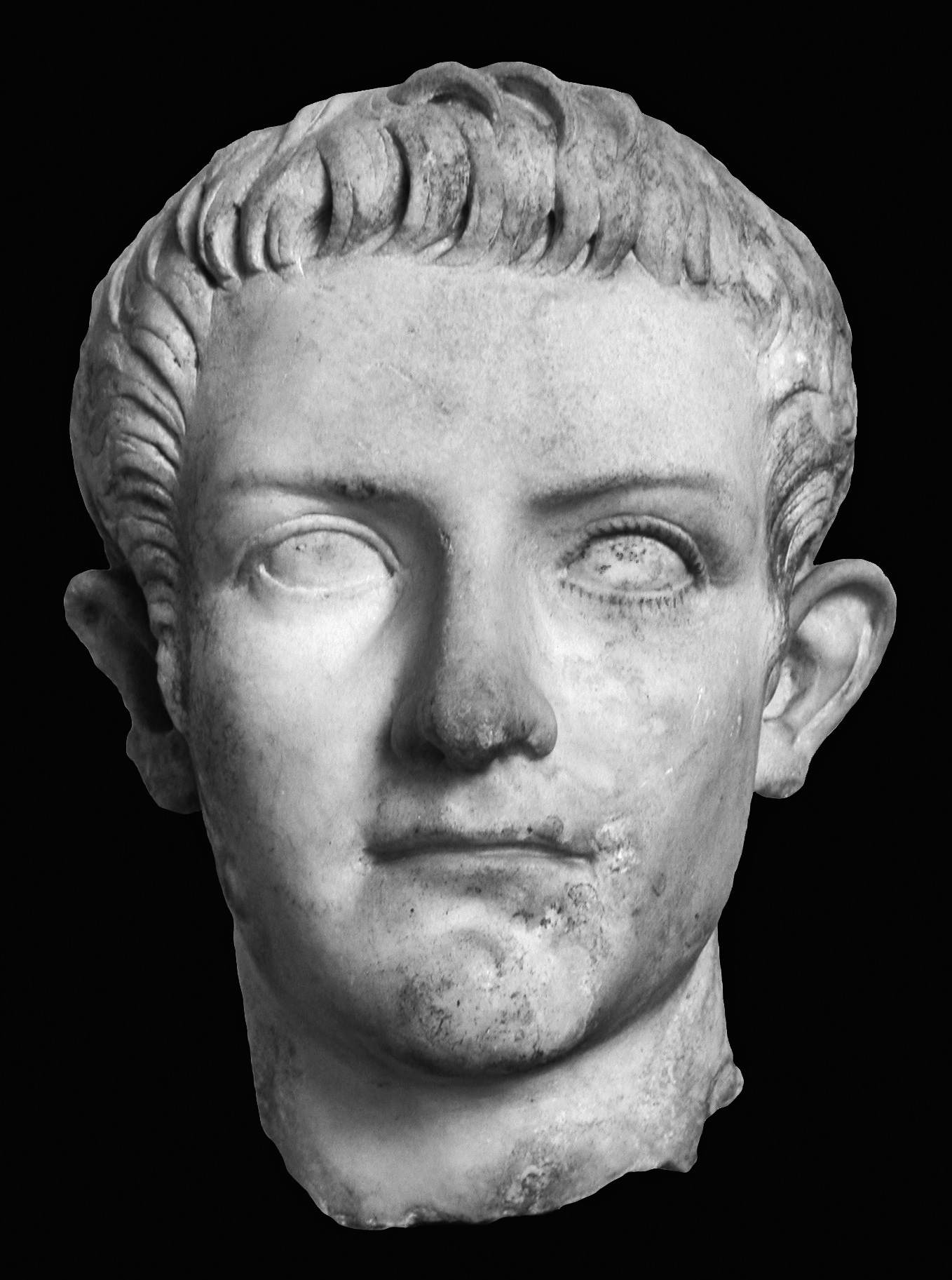 |
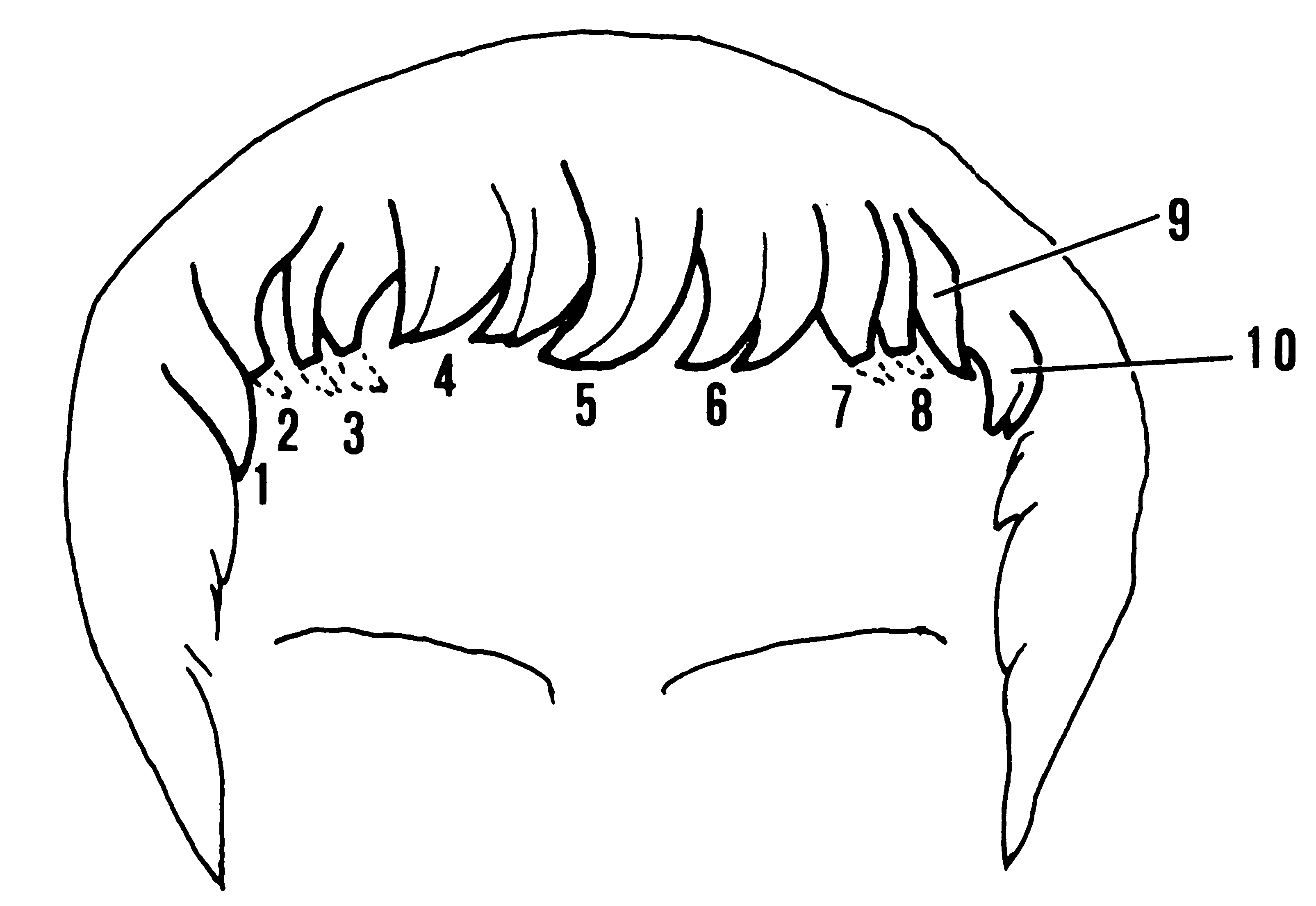 |
| Fig. 12a Head of Caligula, Ny Carlsberg Glyptotek, Copenhagen: Photo author | Fig. 12b Hair scheme of head of fig. 12a: After Boschung (1989) 41, Skizze 17 |
.jpg) |
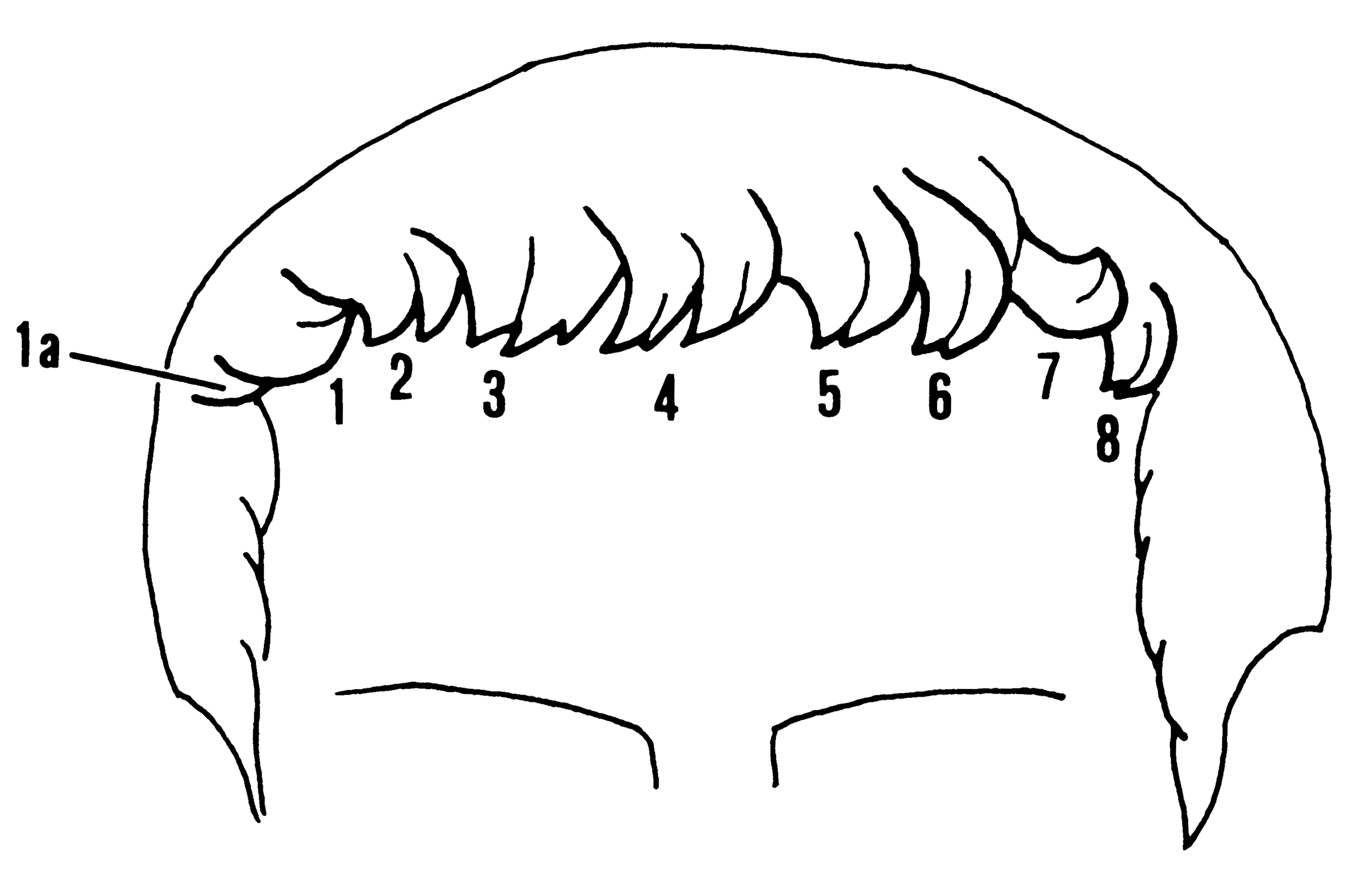 |
| Fig. 13a Head of Caligula in the Yale University Art Gallery: Photo author | Fig. 13b Hair scheme of fig. 13a: After Boschung (1989) 38, Skizze 30 |
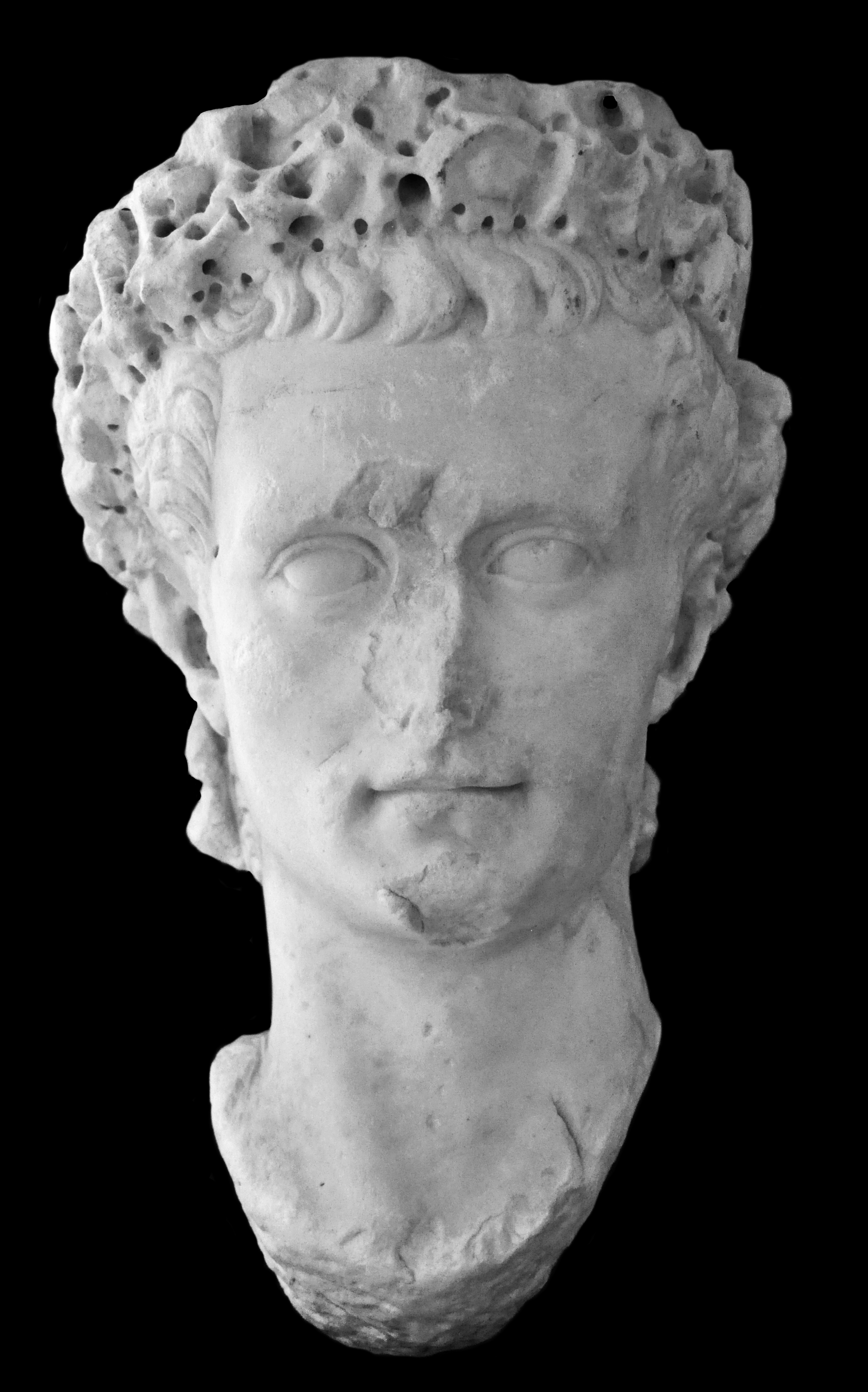 |
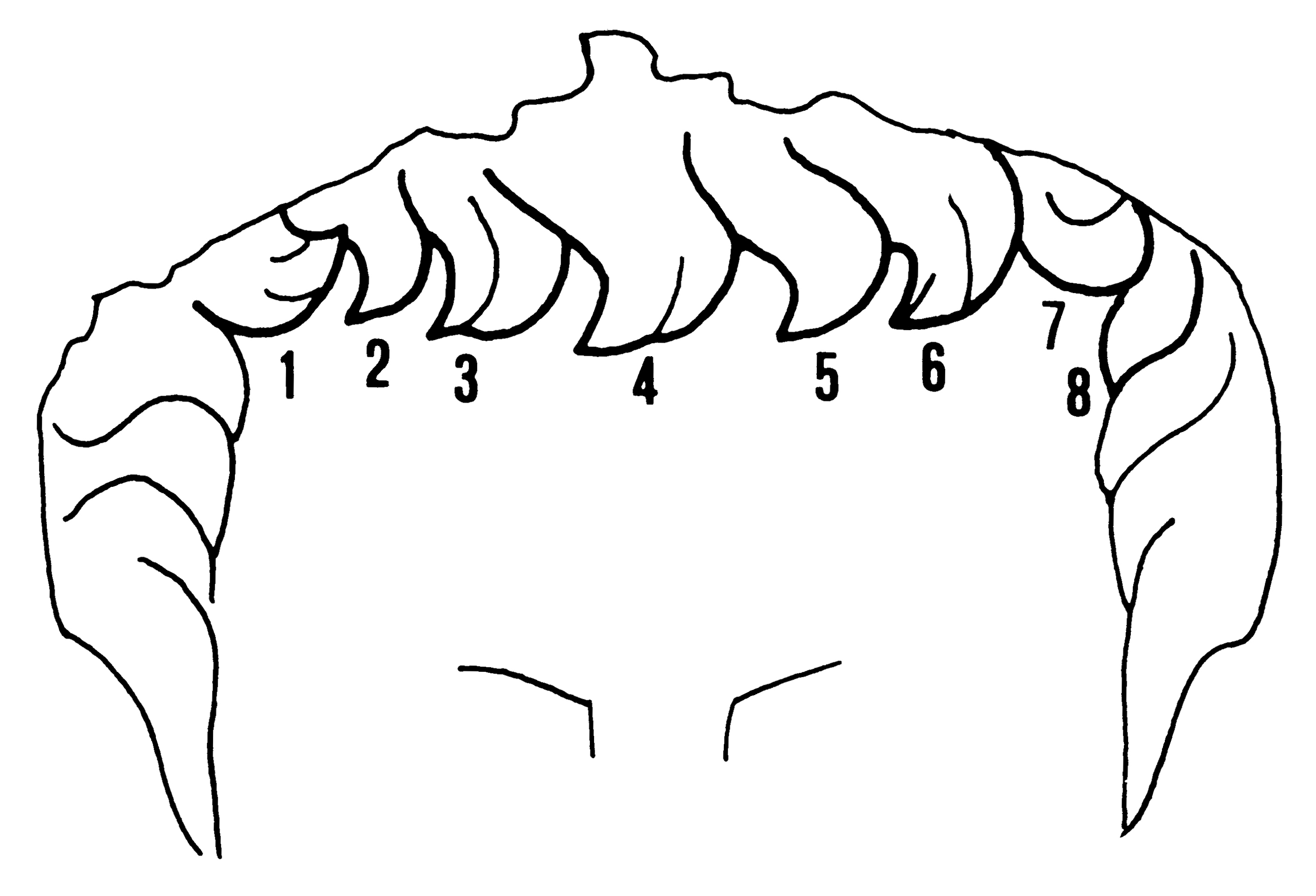 |
| Fig. 14a Head of Caligula in the Museo Archeologico dei Campi Flegrei, Baia: Photo author | Fig. 14b Hair scheme of fig. 14a: After Boschung (1989) 58, Skizze 31 |
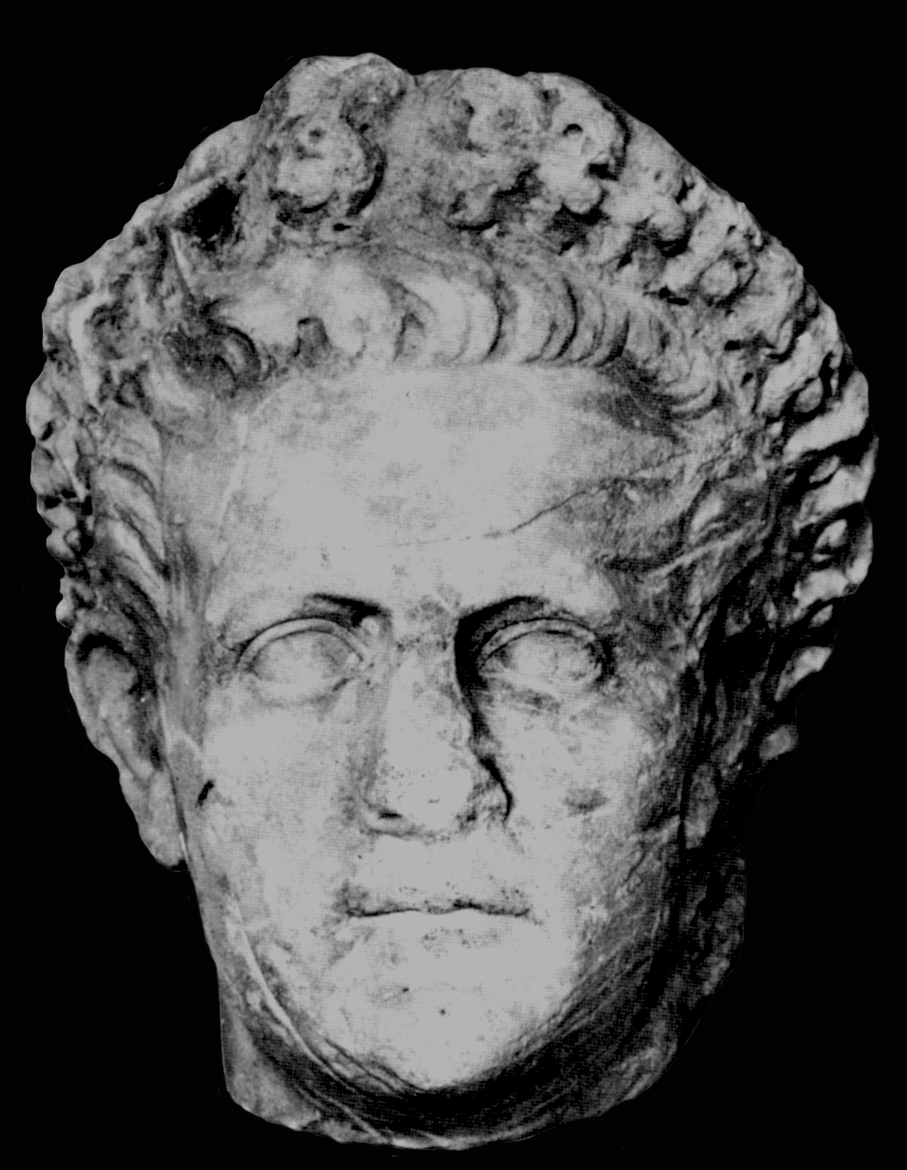 |
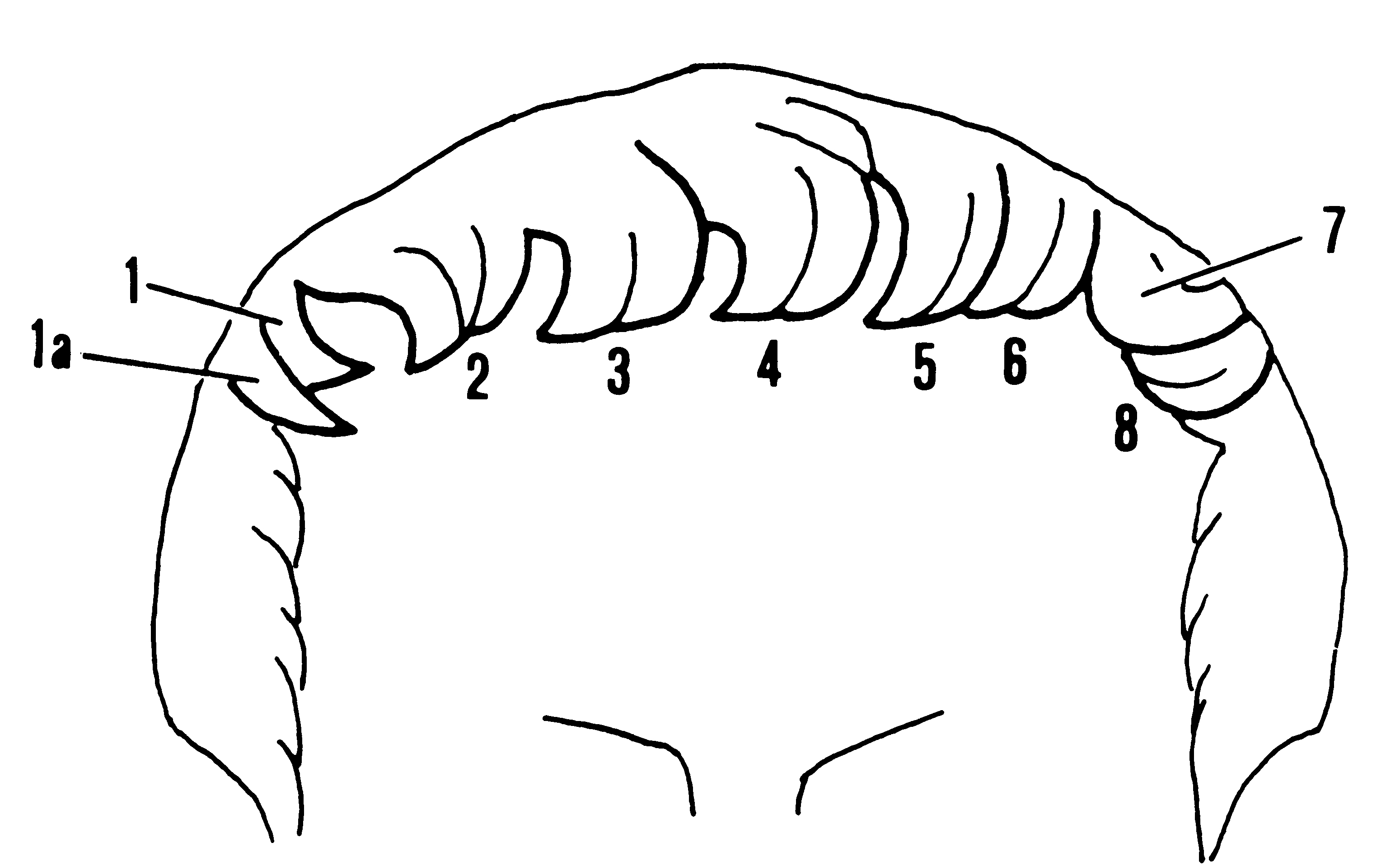 |
| Fig. 15a Head of Caligula in the Museo Civico, Fossombrone: After Boschung (1989) pl. 34.1 | Fig. 15b Hair scheme of fig. 15a: After Boschung (1989) 59, Skizze 32 |
This important difference from the "Haupttypus" in the arrangement of the fringe of hair locks is significant enough, in my view, to constitute an independent principal portrait type and one with sufficient replicas to further justify its designation as a second type (Princeps Type II).[46]
Because of the larger number of extant replicas of the Schloss Fasanerie Haupttypus exemplified by the Schloss Fasanerie head, I agree with Boschung in seeing this as Caligula's first type, created to celebrate his becoming Princeps on 18 March in the year 37 CE at the age of 25 -- hence its alternate designation, the "Accession" type. The greatest number of portraits of any given Princeps will generally be created at the very outset of his principate, when the need to represent the new head of state throughout the Empire was most exigent. Although Caligula's principate was very brief,[47] there was an important sequence of events that took place during his time in power that may have resulted in the creation of a second portrait type (Type II), as reflected in, among others, the Ny Carlsberg head and the Richmond Caligula. About six months into his principate, Caligula fell gravely ill and nearly died.[48] During this critical time, there was an overwhelming outpouring of affection and concern for the popular young leader, not just in Rome but throughout the Empire. In their prayers to the gods, some even vowed to fight as gladiators or offered their own lives if he were spared (Suet. Calig.14.2; Philo leg. ad Gai 15-21). Caligula's recovery, probably by the second half of October of 37 CE,[49] caused great jubilation and was regarded as guaranteeing the safety and stability of the Empire. To celebrate and formally commemorate his restoration to health and the quelling not long after of a suspected conspiracy against him during his illness,[50] it is quite possible that a new portrait type (Princeps Type II) was created that could also be designated his "Salus Augusti" type.[51]
Based on the small number of surviving portraits of Caligula's second type, it appears that it never supplanted in popularity his first portrait type (Princeps Type I = Boschung's "Haupttypus"), probably because in the first (or "Accession") type, Caligula's distinctive hairstyle was intentionally made to ressemble that of his father, the beloved and dashing young military commander Germanicus (fig. 4), who died at the age of 33 in the year 19 CE. Indeed, Caligula's great popularity among the Roman people is attributable in part to the fact that he was the son of Germanicus. Interestingly, Caligula's Princeps Type I portrait appears also to resemble Tiberius' last portrait type, which I have designated Tiberius' "Second Princeps" type (fig. 3).[52] It would seem, then, that Caligula's Princeps Type I portrait was intended to recall not only his father Germanicus but also the continuity of the principate after the death of his great-uncle Tiberius. Although the reclusive Tiberius was himself not much loved by the urban populace of Rome, it was continuity in leadership and the survival of the Julio-Claudian house that mattered most in the ideology of the early empire. The fact that Caligula's Princeps Type II did not supplant his Princeps Type I would indicate again that the imperial government did not attempt to control the choice of types throughout the empire.
An official type obviously represented the Princeps as he wished to appear, not necessarily as he actually looked in life. For example, although Augustus died at the age of 76, all of his portraits show him as more-or-less eternally youthful.[53] In other words, the official Augustan portrait type (or types), representing the "public face" of the Princeps - the face of imperial power - was intended to underscore the stability and enduring nature of the principate, now under the leadership of Augustus' Julio-Claudian successors. Without the evidence of photography, it is of course impossible to know how a person from antiquity actually looked, but it is safe to say that the arrangement of natural hair locks into a fixed iconographic schema, which scholarship tends to fixate on in modern portrait studies in determining who's who, could hardly have been maintained in everyday life (a fact that is generally overlooked in discussions of Roman hairstyles).[54] Therefore, the public face of the leader, with his iconographic hairstyle, was more important than his actual physical appearance. In a vast empire in which few would have ever seen the Princeps in person, it was the portrait image with accompanying identifying label – whether on coinage or in some other medium – that became, in effect, the palpable, physical manifestation of the Princeps, not only to Roman citizens but also to the other peoples of the Empire.[55]
Caligula's official sculptural image obviously presents him as a rather handsome youth in his twenties, reflecting his actual age during his principate. However, descriptions of him in the literary record paint a very different picture, not only of his physical appearance but also of his character.[56] If the few sources that survive are to be believed, Caligula was rather ugly looking or, I should say, as ugly as his character was judged to have been.[57] Although it is said that he could be generous and merciful, he is also described – and probably rightly so – as arrogant, self-important, jealous, cruel, and tyrannical. Such negative traits are not in themselves indicative of clinical insanity,[58] since they are attributed even to the Jewish god Yahweh in the Old Testament.
One of the consequences of the biased, negative portrayals of Caligula in the literary sources, notably Seneca and Suetonius, was that early on in the study of Caligula's portraits, some researchers refused to believe that the "distinguished and friendly" looking portraits that had been correctly identified as Caligula on the basis of numismatic evidence really represented him: after all, the sculptural heads did not match the literary sources, which claimed he was quite ugly.[59] Unfortunately, one of the best Roman historians, Tacitus, says nothing of Caligula's appearance, at least in those pages of his Annales for the principate of Caligula that have survived. Nonetheless, although Tacitus is generally more reliable than other ancient sources, he is hardly unbiased. It is therefore interesting that he does not specifically say that Caligula was insane. Instead, Tacitus characterizes Caligula as ingenio mobili ("fickle by nature" Agr. 13), which would also explain his comment that Caligula's turbata mens ("troubled mind," Ann. 13.3) did not impair his power of speech. Caligula's traits of being arrogant, emotional, petulant, and rash were flaws that he seems to have shared, in part, with his parents. His father Germanicus had acted rashly at times while his mother Agrippina Maior was known for her arrogance and sharp tongue -- personality flaws that ultimately led to her demise.[60] Caligula's fickle nature also accords well with his antics and passion for pantomime, in which a male actor - in this case Caligula - might play the roles of a man, a woman, a god, or a goddess and dress in some rather outlandish costumes. Caligula's theatrical role-playing, however, was not designed for general public consumption but was done in private displays.[61] Much can be explained about Caligula if one separates his public and private actions and forms of representation. For example, on his official coinage, he is always shown appropriately dressed without any of the trappings of divinity that are attributed to him.[62] This, too, is the way he is represented in his image in the Virginia Museum of Fine Arts (click here for images). The titulature on his official coinage is also in keeping with the best official imperial traditions and shows none of the megalomania attributed to him by those who defamed him in their negative literary portrayals.[63] Caligula, thus, presents a case in which historians would do well to assess the literary record against the archaeological, which often presents a somewhat different view of the past, one that is more nuanced.
To understand, in part, how and why Caligula's physical appearance was construed negatively in the ancient literary tradition, we must examine the influence of the Greek pseudo-science of physiognomics on the ancient historical and biographical sources, especially in the thinking and writings of his detractors. Physiognomic theories, which were adopted by the Romans from the Greeks, go back to at least the fifth century BCE and are perhaps best known today from an ancient tract known as the Physiognomica, a work once attributed to Aristotle. More likely, however, this treatise was a third-century BCE creation produced by Aristotle's school of philosophy.[64] This ground-breaking work of nonsense was highly influential for such later Greek writers as Polemon of Laodicea, who lived in the second century CE and also wrote a tract on physiognomics, now known by its Latin title, De physiognomonia.[65] These pseudo-scientific studies maintained that a person's outward appearance could reveal his true nature and inner character. In short, they proposed that there is a definable relationship between what individuals looked like and how they behaved. One of the first proponents of this theory was Zopyrus in fifth century BCE Athens.[66] It is unfortunate that no one in antiquity bothered to test these physiognomical theories out on the image and character of the philosopher Socrates, whose genius and inner beauty were trapped in an outer shell of ugliness: in at least two of his portrait types that have come down to us, he resembles a silenos, or satyr, a likeness that is confirmed by those who personally knew and admired him, namely Plato (Symp. 215-222) and Xenophon (Symp. 5.7).[67] Although physiognomic theory fell out of favor in the Middle Ages, it was revived by the Swiss poet, theologian, and physiognomist Johann Kaspar Lavater in the eighteenth century in his work Physiognomische Fragmente zur Beförderung der Menschenkenntnis und Menschenliebe (Leipzig 1775–1778).[68] Through Lavater and other thinkers and "scientists" of the nineteenth century, the ancient pseudo-science of physiognomics came to play an indirect role in the development of pseudo-scientific theories about racial superiority, culminating in the racist views of the Nazis among others.
Under the influence of physiognomic theory, an ancient author writing about an imperial figure might omit or alter in some way an inconvenient detail about a physical trait if it did not fit the actual or invented character of that individual. For example, although the Roman biographer Suetonius comments on the eye color of certain emperors, he does not report on the eye color of Augustus, whom Suetonius believed to have an excellent character.[69] The eye color of Augustus was certainly known and is preserved in Pliny the Elder's encyclopedic work, the Historia Naturalis (11.143). According to Pliny, the eyes of Augustus were glauci, which most likely means a light sea-gray.[70] The word glaucus is obviously related to glaucoma, the Latin term for cataracts of the eye,[71] in which the opacity of the lens becomes a light gray. This is also the color of the sea when the sky is gray and the sun shines on it. According to some ancient physiognomists, gray eyes were indicative of either a person lacking in humanity and inflexible in nature, or of one who was timid and fearful (Polemon De physiog. 39)[72] -- hardly characteristics that Suetonius would want to attribute to the divine Augustus, whose character he otherwise extolls. Instead, Suetonius reports in his Life of Augustus (79) that Augustus' eyes were "clear and bright/piercing" (oculos habuit claros et nitidos), "in which [Augustus] wished to have it believed that there was a certain divine power" (quibus etiam existimari volebat inesse quiddam divini vigoris). Therefore, Augustus' eyes were probably a piercing light gray color, as in a simulated image of Augustus (fig. 16) based on a portrait in the Munich Glyptothek.[73]
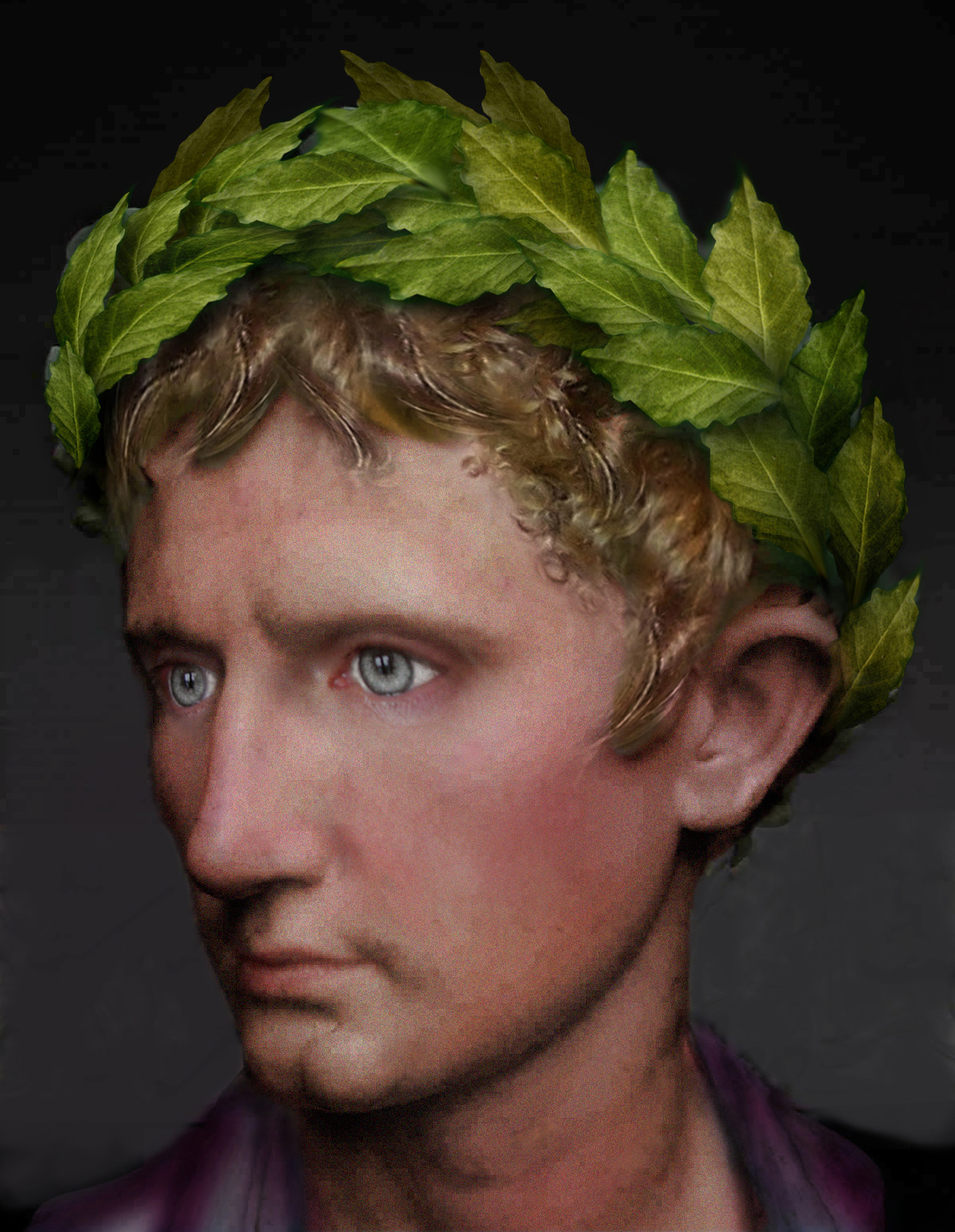
|
| Fig. 16 Simulated portrait of Augustus based on a portrait of Augustus in the Munich Glyptothek (modified by the author): Photo Francis de Andrade. |
Suetonius' characterization was undoubtedly intended to evoke the image of Alexander the Great, whose eyes were said to be "melting" and "limpid,"[74] a description mirroring his divine-given charisma. In the case of Caligula, on the other hand, neither Suetonius nor any of his other critics mentions his eye color, which may have been blue-gray (or caesius in Latin),[75] since this color of the eyes was apparently a dominant Julio-Claudian family trait, as we know specifically in the case of Tiberius (Pliny, HN. 11.142) and Nero (Suet. Nero. 51). In his Life of Caligula, Suetonius notes only that Caligula's "eyes and temples were deep-set" (oculis et temporibus concavis). Interestingly, in physiognomic theory, blue-gray eyes were associated with keen night vision (Pliny, HN 11.142-43). None of the surviving literary sources indicates the color of Caligula's hair, though it may have been brown to light brown, not unlike that of Augustus and Nero, both of whom were said to have hair that was subflavus, which is probably to be understood today as "dirty blond" (e.g., fig. 16).[76] However, this is only an educated guess because of the difficulty in translating ancient color descriptions into modern equivalents.[77]

|
| Fig. 17 Colorized image of the digital model of the Richmond Caligula slightly modified by author. Image: created by Matthew Brennan, Virtual World Heritage Laboratory. |
In another example from ancient physiognomic theory, an ill-proportioned body was regarded as indicative of a rogue, whereas a well-proportioned body was characteristic of an upright and brave man. Hence, Augustus is described by Suetonius (Aug. 79) as having a body that was "extraordinary and most attractive throughout his life" (forma fuit eximia et per omnes aetatis gradus venustissima). By contrast, Suetonius (Calig. 50) describes Caligula as "very tall, with an ill-proportioned body and a complexion that was exceedingly pale. His neck and legs were very thin" (statura eminenti, colore expallido, corpore enormi, gracilitate maxima cervicis et crurum).[78] Suetonius (Calig. 50) declares further that Caligula's "face was by nature dreadful and ugly (vultum vero natura horridum ac taetrum) and [he] made it even more so by his practicing all sorts of terrible and fearsome expressions in a mirror" (etiam ex industria efferabat, componens ad speculum in omnem terrorem ac formidinem). If the mirror story is true, it is understandable that such a young Princeps would want to practice looking serious and stern, even fearsome, in a mirror. Such a torvitas, or fearsome look, was also cultivated by the young Augustus, as evidenced in his early portraiture.[79] Even Winston Churchill was said to have practiced grimacing in a mirror, undoubtedly to make himself seem more serious and formidable, or as the British might say, bull-doggish.[80]
Suetonius also mentions Caligula's "wide and dreadful forehead and hair that was thin and gone on top of his head, but hirsute elsewhere" (fronte lata et torva, capillo raro et circa verticem nullo, hirsutus cetera). Caligula's "wide and dreadful forehead" was considered to be indicative of harshness, shamelessness, avarice, madness, and stupidity; the sparseness of the hair on his head, of libidinous temperament, duplicity, and depravity; his hairy body, of treachery, avarice, and libido.[81] Because of all these features, he could be compared to a goat (Pseudo-Arist. 808b), an animal which -- like the hirsute, goat-legged satyr -- was known for its wanton sexual behavior. Any mention of a goat in Caligula's presence was supposedly -- or at least according to his detractors -- treated as a capital offense (quacumque de causa capram nominare, criminosum et exitiale habebatur Suet. Calig. 50). Caligula's ill-proportioned body, deep-set eyes, and thin neck and legs may also have evoked images of a panther (Pseudo-Arist. 809b-810a), a secretive, deceitful, and stealthy animal,[82] while his paleness was taken as an indication of lust (Pseudo-Arist. 808b) and cowardice (Adamantius Phys. B 33).[83] The association of Caligula with a goat or a panther would have reflected the fact that in the study of physiognomics it was common to compare men with animals considered to possess traits that were either positive or negative. Thus, the physical human qualities of both Augustus and Alexander were described as like those of a lion, the noblest of all animals,[84] while Caligula was compared with animals regarded as having negative characteristics.
Since the physical description of Caligula in the written record has been transmitted to us by his detractors, it cannot be relied upon uncritically in trying to determine his true physical appearance. What can we therefore reasonably conclude about what he looked like? The height of the fringe of locks worn on his forehead in his official portraiture suggests some thinning of the hair. Other traits indicated by the literary sources are that he was on the tall side, slender in build, and most likely had a somewhat fair complexion. In the colorization of the three-dimensional models of Caligula, only his fair complexion is relevant. In the case of the Richmond Caligula, there were no traces of pigment found on the parts of the marble that represent flesh, nor were any pigments found on his hair or in the irises of his eyes, so we cannot know how these vital parts of his body were rendered in this particular statue.[85] Even if we did find traces of color, we cannot assume that this coloration would have accurately represented Caligula's actual appearance, for art -- more often than not -- is different from reality.
Attempts have also been made recently to reconstruct the polychromy of the famous portrait of Caligula in the Ny Carlsberg Glyptotek in two colorized copies in Carrara marble, Version "A" (fig. 18)[86] and Version "B" (fig. 19).[87]
Although traces of pigments have been found on the hair and face of the Ny Carlsberg head, we cannot be sure of the final look of this portrait: We do not know how these traces of paint might have been combined with other pigments that no longer survive to produce the subtle tonalities in representing flesh, hair, and eyes that we would expect in such a high quality work of art. And even if the colorization of the improved reconstructed model "B" were more-or-less correct, this does not mean that all the polychrome replicas set up throughout the Empire were uniform in their coloration. Again, the diversity of ways in which the portrait features and hairstyles are rendered in Caligula's portraiture argues against any such uniformity.
Based on Version "B" of the Ny Carlsberg Caligula, I have produced a computer-generated Version "C" (fig. 20) in which the skin tone of the earlier versions has been lightened to reflect the fact that ancient descriptions indicate that Caligula had a somewhat fair complexion, although he probably was not as excessively pale as his critics would have us believe in order to suggest that he was cowardly.

|
| Fig. 20 Colorized Version "C" of the Ny Carlberg Glyptotek Caligula (Version "B" modified by author): After Brinkmann and Scholl, edd. (2010) 228 |
I also changed the color of the irises of his eyes from brown to blue-gray, based on what may have been a family trait, as far as we can determine from the ancient sources characterizing this color as caesius. The most recent technical analysis indicates that there was a concentration of the pigment Egyptian blue in the area of the pupil and iris of the right eye of the Ny Carlsberg head (fig. 21).[88]
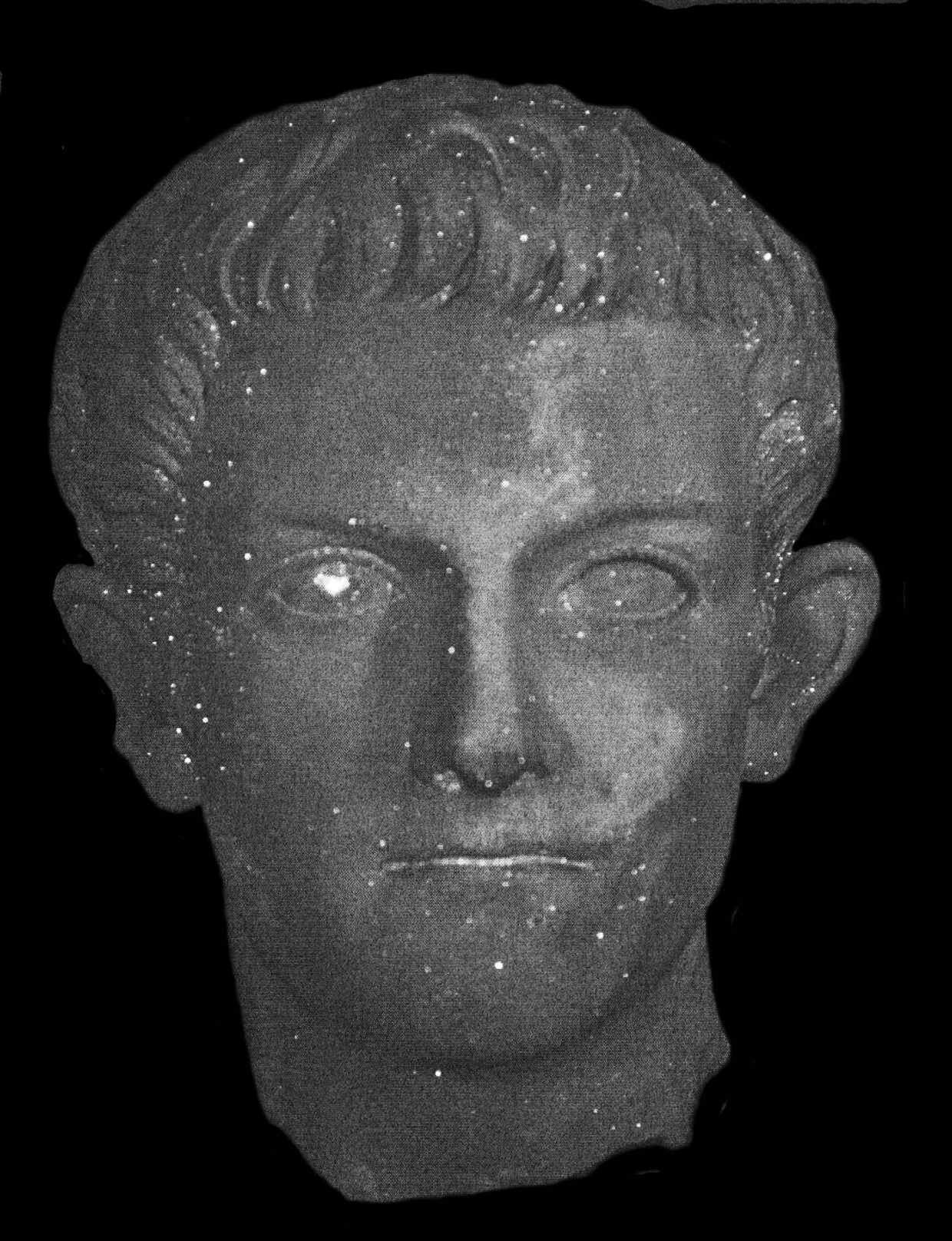
|
| Fig. 21 Image indicating distribution of glowing white particles of Egyptian Blue on the Ny Carlsberg Caligula: After Sargent and Therkildsen (2010) fig. 11 |
The Egyptian blue, however, was a foundation layer. The pigments that were ultimately used above this layer to create the color of the iris have not been established. A bronze bust of Caligula in the Metropolitan Museum of Art in New York (fig. 22) with a blue-gray iris in his proper right eye and a somewhat brighter bluish or bluish-green iris in his proper left eye initially appeared to support the idea of Caligula's eyes having been blue-gray, but a recent technical analysis of the eyes of this portrait proved inconclusive with regard to the original color of the irises.[89]
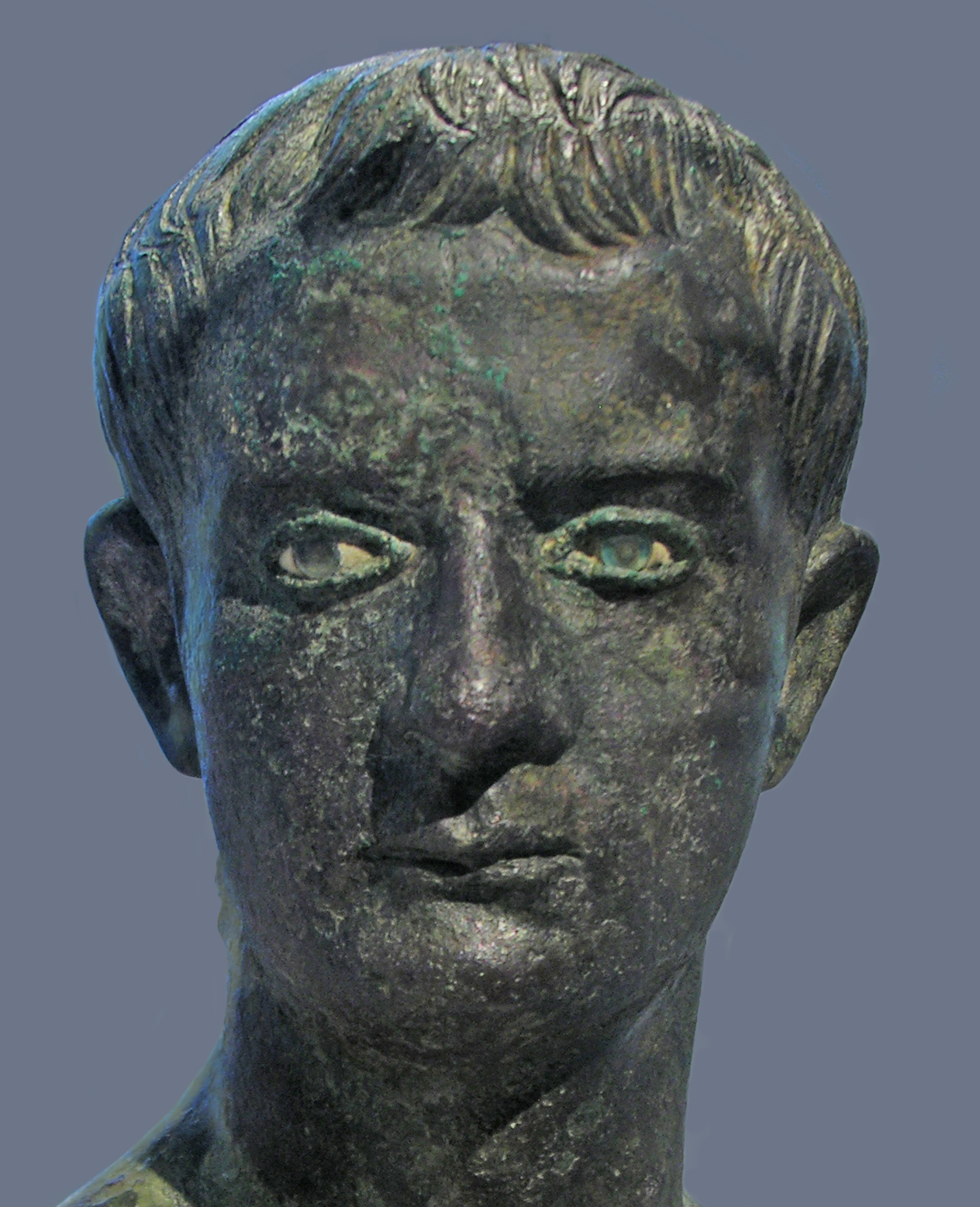
|
| Fig. 22 Bronze bust of Caligula in the Metropolitan Museum of Art, New York: Photo author |
In Version "C" (fig. 20), it is not my intent to show how this particular sculpture must have once looked, although this may well be an accurate reconstruction of its coloration. I am more interested in suggesting how a high quality official portrait model from Rome might have appeared, based on both actual traces of paint on the Ny Carlsberg head and what we can glean from the biased accounts of his appearance in the ancient sources. If any image fairly accurately reproduced Caligula's skin, hair, and eye colors in polychrome sculptural portraits, then surely it would have been an officially commissioned prototype, presumably produced by a leading Roman workshop. In addition, I have had reproduced another computer-generated version of the Richmond portrait (Fig. 17),[90] which reflects the same changes as my Version "C" of the Ny Carlsberg head (fig. 20).[91] These new versions of Caligula's portraits should be thought of as only two among a number of many possibilities, based on all our existing "paradata," to borrow a term from Bernard Frischer in this symposium.[92] In short, such polychrome reconstructions can only be educated guesses, since so few traces of ancient pigment on a given work have come down to us and since so much remains unknown. As I like to tell my students, the study of the past is like looking at a slice of Swiss cheese, which not only has many holes in it, but irregular ones at that!
* I dedicate this article to John D. MacIsaac, a former graduate student of mine at Johns Hopkins University in the 1980s, who after receiving his Ph.D. went on to teach at several institutions of higher education, including the University of Mary Washington until his retirement in 2007. Above all, John had a passion for numismatics. Among his contributions to the field was his work on the coins at Nemea (Greece), published with R.C. Knapp in Excavations at Nemea III: The Coins (Berkeley 2005). Always helpful, kind, and a pleasure to be with, John will be greatly missed.
Note: All translations of Latin are by the author.
Bibliography
Barrett, A. Caligula: The Corruption of Power (New Haven 1989).
Bonanno, A. Roman Relief Portraiture to Septimius Severus (BAR Suppl. Series 6) (Oxford 1976).
Boschung, D. Die Bildnisse des Caligula Das römische Herrscherbild (Das römische Herrscherbild 1.1) (Berlin 1989).
Boschung, D. "Die Bildnistypen der iulisch-claudischen Kaiserfamilie: ein kritischer Forschungsbericht," JRA 6 (1993a) 39-79.
Boschung, D. Die Bildnisse des Augustus (Das römische Herrscherbild 1.2) with "Beitrag" by H.-M. von Kaenel (Berlin 1993b).
Boschung, D. Gens Augusta: Untersuchungen zu Aufstellung, Wirkung und Bedeutung der Statuengruppen des julisch-claudischen Kaiserhauses (Monumenta Artis Romanae XXXII) (Mainz 2002).
Bradley, M. Colour and Meaning in Ancient Rome (Cambridge 2009).
Brinkmann, V. and A. Scholl, edd. Bunte Götter: Die Farbigkeit antiker Skulptur: Eine Ausstellung der Antikensammlung, Staatliche Museum zu Berlin (Berlin 2010).
Charbonneaux, J. "Deux portraits romains inédits: Drusus l'Ancien et Drusus le Jeune," in Neue Beiträge zur klassischen Altertumswissenschaft: Festschrift zum 60. Geburtstag von Bernhard Schweitzer (Stuttgart 1954) 331-33.
Couisson, J. "Suéton physiognomiste dans les vies des XII Césars," REL 31 (1953) 234-56.
Evans, E.C. Physiognomics in the Ancient World, TAPS 59 (1969).
Fabbrini, L. "Il ritratto giovanile di Tiberio e la iconografia di Druso Maggiore," BdA 49 (1964) 304-26.
Fejfer, J. Roman Portraits in Context (Berlin 2008).
Fittschen, K. "I ritratti di Germanico," in Germanico: La persona, la personalità, il personaggio (Atti del Covegno, Macerata-Perugia, 9-11 maggio 1986), edd. G. Bonamente and M.Paola Segoloni (Rome 1987) 205-18.
Fittschen K. and P. Zanker, Katalog der römischen Porträts in den Capitolinischen Museen und den anderen Kommunalen Sammlungen der Stadt Rom (Mainz 1983) III.
Giard, J.B. Le grand camée de France (Paris 1998).
Giuliani, L. and G. Schmidt, Ein Geschenk für den Kaiser: Das Geheimnis des großen Kameo (Munich 2010).
Hoff, R. von den and A. Dobler, edd. Antike, Glanzpunkte der Sammlung griechischer und römischer Kunst aus dem Hause Hessen (Fulda 2005).
Højte, J.M. Roman Imperial Statue Bases: From Augustus to Commodus (Aarhus Studies in Mediterranean Antiquity 7) (Aarhus 2005).
Inan, J and E. Alföldi-Rosenbaum, Römische und Frühbyzantinische Porträtplastik aus der Türkei: Neue Funde (Mainz 1979).
Johansen, F. Catalogue: Roman Portraits I (Copenhagen 1994).
Kersauson, K. de. Catalogue des portraits romains I: Portraits de la République et d'époque Julio-Claudienne (Musée du Louvre) (Paris 1986).
Kiss, Z. L'Iconographie des princes Julio-Claudiens au Temps d'Auguste et de Tibère (Warsaw 1975).
Kraus, T. Das römische Weltreich (Propyläen Kunstgeschichte II) (Berlin 1967).
Kunze, M. et al. Die Antikensammlung im Pergamonmuseum und in Charlottenburg (Berlin 1992).
Lahusen, G. and E. Formigli, Römische Bildnisse aus Bronze: Kunst und Technik (Munich 2001).
Landwehr, C. Die antiken Gipsabgüsse aus Baiae (Archäologische Forschungen 14) (Berlin 1985).
Megow, W.-R. Kameen von Augustus bis Alexander Severus (Antike Münzen und Geschnittene Steine XI) (Berlin 1987).
Pekáry, T. Das römische Kaiserbildnis in Staat, Kult und Gesellschaft dargestellt anhand der Schriftquellen (Das römische Herrscherbild 3) (Berlin 1985).
Pollini, J. "A Pre-Principate Portrait of Gaius (Caligula)?" JWalt 40 (1982) 1-12.
Pollini, J. The Portraiture of Gaius and Lucius Caesar (New York 1987).
Pollini, J. "Man or God: Divine Assimilation and Imitation in the Late Republic and Early Principate," in Between Republic and Empire: Interpretations of Augustus and His Principate, edd. K.A. Raaflaub and M. Toher (Berkeley 1990) 333-63.
Pollini, J. "The Gemma Augustea: Ideology, Rhetorical Imagery, and the Creation of a Dynastic Nararive, in Narrative and Event in Ancient Art (Cambridge 1993), ed. P.J. Holliday (Cambridge 1993) 258-98.
Pollini, J. Review article of Die Bildnisse des Augustus by D. Boschung, ArtB 81 (1999) 723-35.
Pollini, J. "A New Marble Portrait of Tiberius: Portrait Typology and Ideology," Antike Kunst 48 (2005) 57-72.
Pollini, J. From Republic to Empire: Rhetoric, Religion, and Power in the Visual Culture of Ancient Rome (Norman, Okla. 2012).
Riccardi, L.A. "Military Standards, Imagines, and the Gold and Silver Imperial Portraits from Aventicum, Plotinoupolis, and the Marengo Treasure," AntK 45 (2002) 86-99.
Richter, G.M.A. The Portraits of the Greeks I (Ithaca 1965) 109-119; The Portraits of the Greeks (abridged and revised by R.R.R. Smith) (Oxford 1984) 198-204.
Rockwell, P. The Art of Stoneworking: A Reference Guide (Cambridge 1993).
Rose, C.B. Dynastic Commemoration and Imperial Portriature in the Julio-Claudian Period (Cambridge 1997).
Sargent, M.L. and R.H. Therkildsen, "The Technical Investigation of Sculptural Polychromy at the Ny Carlsberg Glyptotek 2009-2010 - An Outline'," in J.S. Østergaard, ed., Tracking Colour. The polychromy of Greek and Roman Sculpture in the Ny Carlsberg Glyptotek. Preliminary Report 2 (Copenhagen 2010); also online: http://www.glyptoteket.dk/tracking-colour2.pdf.
Shookman, E. ed. The Faces of Physiognomy: Interdisciplinary Approaches to Johann Caspar Lavater (Columbia, SC 1993).
Stewart, A. Faces of Power (Berkeley 1993).
Stucchi, S. "Interpretazione e datazione dei bronzi da Cartoceto," in Bronzi dorati da Cartoceto (Florence 1987) 51-63.
Sutherland, C.H.V., The Emperor and the Coinage (Julio-Claudian Studies) (London 1976).
Varner, E.R. Mutilation and Transformation: Damnatio Memoriae and Roman Imperial Portraiture (Leiden 2004).
Vermeule, C. Roman Art in Greece and Asia Minor (Cambridge, MA 1981).
Walker, S., ed. Ancient Faces: Mummy Portraits from Roman Egypt, 2nd ed. (New York 2000).
Wardle, D. Suetonius' Life of Caligula. A Commentary (CollLatomus 225) (Brussels 1994).
Wilkinson, S. Caligula(New York 2005).
Winkler, L. Salus: vom Staatskult zur politischen Idee. Eine archäologische Untersuchung (Archäologie und Geschichte 4) (Heidelberg 1995).
Winterling, A. Caligula: A Biography, trans. from the German (Berkeley 2011).
Zanker, P. Provinzielle Kaiserporträts: Zur Rezeption der Selbstdarstellung des Princeps, AbhMünch 90 (1983).
Zevi, F. et al., Museo Archeologico dei Campi Flegrei, Catalogo generale I: Cuma (Naples 2008).
Zevi, F. et al., Museo archeologico dei Campi Flegrei: Catalogo generale, III: Liternum, Baia, Miseno (Naples 2008).
Footnotes
[1]See Chapter VIII, "The 'Insanity' of Caligula or the 'Insanity' of the Jews? Differences in Perception and Religious Beliefs," in Pollini (2012) 369-411. For the confusion between worshiping the Genius or Numen of the living Princeps (emperor) and worshiping the living person, see also in this same work Chapter VII, "The Smaller Cancelleria ('Vicomagistri') Reliefs and Imperial Julio-Claudian Imperial Altars: Limitations of the Evidence and Problems in Interpretation," 309-68.
[2]See further Chapter VIII (n. 1 above) in Pollini (2012).
[3]Barrett (1989).
[4]See, for example, Wilkinson (2005), especially his excellent concluding chapter (187-94) "Inventing the Mad Emperor, " and Winterling (2011). For a different point of view, see in this symposium Vasily Rudich's paper, "On the Reputation of Little-Boots."
[5]There has been little agreement in the past on the cast of characters on this great cameo. See now especially Megow (1987) 202-207 (cat. A 85) pls. 32.5-10, 33.1-5; Boschung (1989) 64-68; Giard (1998); Giuliani and Schmidt (2010).
[6]For Tiberius: Pollini (2005), especially Types I and VI, fig. 2.
[7]The closest parallel for the entire fringe of hair of Caligula's boyhood portrait is that of his father Germanicus on the Gemma Augustea: Megow (1987) 8-9, pl. 6.5-6; Pollini (1993) 268. This Gemma portrait of Gemanicus is his first known portrait type ("Adoption" type), which dates to 4 CE. The forking of the hair over the center of the forehead is also to be found in Germanicus' third portrait type, the so-called "Gabii" type, most likely created at the outset of the Principate of Caligula (here fig. 4). This portrait type of Germanicus was probably intended to resemble Tiberius' last portrait type (in my opinion, the "Chiaramonti" type (Type VI; here fig. 3), created around 31 CE), and Caligula' first type (here fig. 12a-b), created in 37 upon his accession as Princeps. For Tiberius' "Chiaramonti" type, see Pollini (2005) 59, fig. 2, 66-68, pl. 12.3,4. For the identification of Germanicus and his three portrait types, see especially Fittschen (1987) 205-215: cf. Boschung (1993a) 59-61; Rose (1997) 64-65.
[8]Distinguishing the portraiture of Germanicus (15 BCE-19 CE) and that of his two older sons, Nero Iulius (ca. 6-31 CE) and Drusus Iulius (ca. 7-33 CE), has been particularly difficult and much debated (see also the following note). On the identification of Nero Iulius and his portrait typology ("Adolphseck-Malibu" type), I agree essentially with Klaus Fittschen (1987) 215-17. Cf. Boschung (1993a) 64-65; Rose (1997) 66-67. In my opinion, this type agrees with the portrait of Nero Iulius on the Grand Camée de France (armored figure in front of Tiberius): See Fittschen (1987) 216-17, fig. 43 (detail). For the Grand Camée, see n. 5 above. A pronounced hooked nose is one of the characteristics of Nero Iulius' portrait, which is paired with that of his brother Drusus Iulius on provincial coins of Tiberian date: See especially a coin of Aphrodisias: See Stucchi (1987) 54-55, fig. 1d (senior member of the paired images Nero Iulius on left; junior partner Drusus Iulius on right).
[9]For the identification of Drusus Iulius and his portrait typology ("Corinth-Stuttgart" type), I would agree in general with Fittschen (1987) 217-18; cf. Boschung (1993a) 66-67; Rose (1997) 66-67. A portrait statue of Drusus Iulius (Germanici) from the Augusteum, or imperial cult shrine, in ancient Rusellae, now in the Museo Archeologico in Grosseto, may be identified as that of Drusus Iulius, if an inscription with his name from the same context can be associated with this image (a portrait of his brother Nero Iulius was presumably also once represented in the same group of imperial figures). For this statuary "cycle," see now Boschung (2002) 69-76 (the portrait that I take as Drusus Iulius, Boschung (70) considers to be Nero Iulius: no. 20.6, pl. 60.2). For the inscription with Drusus Iulius' name, see 71 (no. 20.27). By comparison with Nero Iulius' nose with its pronounced hook (here fig. 5b), that of Drusus Iulius has only a slight bump (here fig. 6b), discernible in the figure of Drusus Iulius (armored figure behind Tiberius) on the Grand Camée: For detailed views of these figures, see Fittschen (1987) fig. 43 (Nero Iulius), 45 (Drusus Iulius); Megow (1987) pl. 32.10 (Nero Iulius), pl. 33.3 (Drusus Iulius). This difference can also been seen on the provincial Tiberian coin from Aphrodisias cited in the previous note.
[10]From the Tiber, now in the Museo Nazionale Romano al Palazzo Massimo (inv. 4256): Boschung (1989) 112 (cat. 19) pls. 19.1-4.
[11]Institut National d'Archéologie et d'Art (Tunis): Pollini (1982) 6, fig. 12; Boschung (1989) 110-111 (cat. 14), pls. 14.1-4. For the diversity of Augustus' portraits throughout the Empire, see Pollini (1999) 731. Over 250 portraits of Augustus have come down to us.
[12]For his coinage and for images of Caligula in right and left profile views, see H.-M. von Kaenel in Boschung (1989) 15-26, pls. A-E.
[13]Further evidence can be provided by imperial symbols, such as the corona civica (oak crown) or the detection of traces of Caligula's portraiture (usually his iconographic hairstyle) in heads that were recut into images of his predecessors Augustus and Tiberius or his successor Claudius. See further Boschung (1989) 29 with nn. 15-17.
[14]For portraits in the form of paintings, see Pollini (1987) 11. We also know of a colossal 120-foot-high painting on linen of Nero (Plin. HN 35.51). In addition, there are many funerary portraits on wood from Fayum: see, e.g., Walker (20002*). For a painted wooden disc of Septimius Severus and his family (with the face of Geta as a boy erased after his later damnation by his brother Caracalla) in the Staatliche Museen zu Berlin (Altes Museum): Kraus (1967) 214 (cat. 156) fig. 156; Kunze et al. (1992) 306 (cat. 168) color image.
[15]For portrait typology and associated problems in general, see Pollini (1999) with further bibliography.
[16]See Pollini (1987) 2-3, n. 11 and (1999) 731 with further bibliography. We have no direct evidence for how this process actually worked, at least in the early Empire, though there are a number of literary and inscriptional references to the distribution and reception of imperial portraits during the late Empire, especially from the fourth century on: See Ando (2000) especially 228-32. There is evidence, moreover, for plaster casts being used for the making of large-scale three-dimensional models of Greek "Idealplastik": See Landwehr (1985) and recently Zevi et al. (2008) 80-116.
[17]In the past, a terracotta head of Drusus Minor in the Louvre had been taken as a possible workshop model, based on its odd-looking, wide-splayed base. Even traces of pigment were reportedly found on this head. See Mus. inv. CA2987: Charbonneaux (1954) 331-33, pl. 72; Fabbrini (1964) 304-26; Kiss (1975) 99, figs. 312-13; Kersauson (1986) 168-69 (cat. 78). However, based on thermoluminescence analysis at C2RMF (National lab) by Antoine Zink in 2004 (1906-1952 AC), it was determined by the conservation department of the Louvre that this terracotta head was not ancient. I thank Ludovic Laugier in Conservation at the Louvre for this information.
[18]As suggested recently to me by Jan Stubbe Østergaard. These would presumably be like the wax ancestral masks of the Roman nobility that were life-masks. For these wax ancestral masks, see Chapter I, "Ritualizing Death in Republican Rome: Memory, Religion, Class Struggle, and the Wax Ancestral Mask Tradition's Origin and Influence on Veristic Portraiture," in Pollini (2012) 13-68.
[19]See in general, for example, Zanker (1983).
[20]A distinction should be made between imperial imagery found on coinage of the Roman State and that on municipal or provincial coinage. See Pollini (1990) and Chapter II, "The Leader and the Divine: Official and Nonofficial Modes of Representation," in Pollini (2012) 69-132. With regard to the debate about who was responsible for the selection of coin types, as well as their intent, see especially Sutherland (1976) 5-33.
[21]Zanker (1983) does not talk about the direct involvement of imperial agents in the distribution of non-numismatic imperial portrait images to the armies of the Empire, but only sees distribution through the art market, stating (8-9), "Die Verbreitung selbst scheint von den Kaisern nicht zentral organisiert gewesen, sondern wohl auf dem Wege des Kunsthandels und der Verbindung der Werstätten untereinander erfolgt zu sein. Dabei kann man auch an Agenten denken, die die Werkstätten von Rom aus unter Billigung des Kaisers belieferten."
[22]See Pekáry (1985) 43 with further bibliography.
[23]Riccardi (2002) 93-97.
[24]Bonanno (1976) 147-49, fig. 284. For other similar imperial images on standards in Roman relief art, see Riccardi (2002) 97-98. I thank H.R. Goette for allowing me to use images of the standards on the Arch of the Argentarii (my fig. 8a-b) and for allowing me to read a lecture of his, "The Portrait Representation of the Emperor Caligula Caius Iulius Caesar Germanicus."
[25]For this small bronze bust in a Swiss private collection (height: 9.7 cm), which H. Jucker had proposed might have once been part of a Roman standard, see Boschung (1989) 91, 115 (cat. 30) pl. 27.1-4. As H.R. Goette suggested (see previous note), the type of cuirass (lorica plumata or squamata) worn by Caligula in this bust may have some reference to the Praetorian Guard. For representations of small metal busts of emperors decorating Roman standards and as finials atop poles, see Riccardi (2002) especially 94-99 and fig. 23.1.
[26]See Chapter VII "The Smaller Cancelleria ('Vicomagistri') Reliefs and Julio-Claudian Imperial Altars: Limitations of the Evidence and Problems in Interpretation," in Pollini (2012) 309-68, especially 311-15.
[27]With regard to this process, see Pollini (1999) with further bibliography.
[28]For these sorts of images, see in general Boschung (1989).
[29]For some of these recut images of Caligula, see the catalogue entries in Boschung (1989). See also Varner (2004) 23-34. For the removal or preservation ("warehousing") of Caligula's portraits, see 35-45. Varner (38-39) assumes that Caligula's images, even small bronzes that might have been set up in domestic shrines, would have been removed after his assassination (39): "Following his downfall in 41, it would no longer have been permissible or even desirable to display portraits of Caligula in either sacra privata or sacra publica." Some of the small bronze busts were indeed cast into the Tiber, as noted above (with n. 27). However, I am not sure how extensive this practice was. We know, for example, that portraits of Brutus and Cassius were still displayed after their deaths. As in the case of admirers of the assassins of Caesar, Caligula would have had his devoted followers after his death (as also Nero), especially since Claudius himself refused to condemn the memory of Caligula. In fact, Caligula's continued popularity in certain circles of society may in part have been why Claudius did not have Caligula's memory officially damned. See also Varner (2004) 42-44, who notes that some of Caligula's images were allowed to stay on display in group dedications with portraits of other family members.
[30]See the paper presented by Eric Varner in this symposium, "Beyond Damnatio Memoriae: Memory Sanctions, Caligula's Portraits and the Richmond Togatus."
[31]On the copying process, see in general Rockwell (1993) 118-125, especially 122. See also Pollini (1999) 731.
[32]See, e.g., Pollini (1987) especially 8-17 with further bibliography; Pollini (1999) especially 723.
[33]See above n. 15.[34]See Boschung (1989) 29, 31-58.
[35]Boschung (1989) 58.
[36]Boschung (1989) 60-62.
[37]See further Pollini (1999) 723-35.
[38]Boschung (1989) 32-35, 108 (Cat. 5) pl. 5.1-4; Hoff and Dobler, edd. (2005) 28-29 (cat. 3).
[39]Based on the style of the head and the strong connections of the collector, Landgraf Philipp von Hessen, with Italy and Rome in particular: Hoff and Dobler, edd. (2005) 11-23.
[40]See the paper in this symposium by Maria Grazia Picozzi, "The Modern History of the Richmond Caligula." Epigraphical evidence (fragments of fasti of the Sodales Augustales Claudiales) were found in the same building where the statue was found. This structure was probably the Sacrarium Gentis Iuliae ("Shrine of the Gens Iuliae") dedicated by Tiberius in 16 CE with a statue of Divus Augustus (Tac. Ann. 21: sacrarium genti Iuliae effigiesque divo Augusto apud Bovillas dicantur). On this imperial cult building at Bovillae, see further in this symposium Paolo Liverani's paper, "Caligula: Notes and an Hypothesis on the Context." As was customary, over time portraits of other members of the imperial house were added to these shrines. See further Liverani and the joint paper by Jan Stubbe Østergaard, "Reflections on the Typology and Context of the Richmond Caligula."
[41]Mus. inv. 70-20: Boschung (1989) 38-39, 109-110 (cat. 11) pls. 42.1-4, 43.
[42]For the Ny Carlsberg head (inv. 2687), which presumably comes from Istanbul, see Boschung (1989) 29, 41-43, 111-12 (cat. 18) pls. 17, 18.1-4; Johansen (1994) 136-37. Since Istanbul is the center of the art market for antiquities in Turkey, it is possible that the head came from there rather than from Italy, as C. Vermeule once believed purely based on style: Vermeule (1981) 387, no. 2. In any case, Boschung does not take this image as belonging to his Nebentypus, but considers it instead to be a variant and "Typenklitterung" of his Haupttypus. In my opinion, this portrait stands closer to his Nebentypus than his "Haupttypus," or what I consider Caligula's second portrait type.
[43]Mus. inv. 1.1963: Boschung (1989) 116-17 (cat. 37) pls. 31, 32.1-3.
[44]Mus. inv. 151073 (= Antiquario Flegreo 68): Boschung (1989) 117 (cat. 38) pl. 33.1-4; Zevi et al. (2008) 341.
[45]Boschung (1989) 117 (cat. 39) pl. 34.1-4.
[46]See also Boschung's conclusion (1989) 101.
[47]See Barrett (1989) 54 for Caligula's becoming Princeps; for his death, 169-71. For a useful time-line of events in Caligula's short Principate of approximately three years and 10 months (18 March 37 to 22 or 24 January 41): Barrett (1989) xiii.
[48]Barrett (1989) 73 estimates that Caligula's illness took place after September 21, when the Senate gives him the title of Pater Patriae.
[49]See Barrett (1989) 73.
[50]The conspiracy was suspected to have taken place during his illness and to have centered on Caligula's adopted son Gemellus and Caligula's father-in-law Silanus, who met their deaths by the end of 37: Barrett (1989) 74-75.
[51]By the time of the Principate, the salus of the State came to be equated with the valetudo ("health") of the Princeps. On this point, see Winkler (1995) 40-4, 48-9. Boschung (1989) 102, however, suggested the possibility that his "Nebentypus" might have celebrated Caligula's acceptance of the title "Pater Patriae" in September of 37, though he had become de facto Pater Patriae when he became Princeps.
[52]See Pollini (2005) 67-68, fig. 2 (Type VI).
[53]See Boschung (1993b); Pollini (1999).
[54]One clear exception being a wig, which was sometimes used by imperial women and represented in Roman art, especially from the Flavian - Trajanic periods, when beehive-like hair bonnets were popular. Some wig-like hair pieces were carved separately and could be added (or exchanged) in portrait heads. See, e.g., Fittschen in Fittschen and Zanker (1983) 83 (cat. no. 113), pls. 142-43.
[55]For inscribed imperial statue bases, see in general Højte (2005). For portraits statues in context, see Fejfer (2008).
[56]For the ancient sources, see nn. 2-3; Evans (1969) 54-55.
[57]The earlier contemporary sources are especially now known from the second century CE biographer Suetonius' Life of Caligula (50). See further Wardle (1994) 323-30.
[58]See Chapter VIII (n. 1 above) in Pollini (2012), which among other things presents a new interpretation of Caligula's decree to have a statue of himself set up in the Temple of the Jewish god in Jerusalem that is very different from what has been proposed before. Contrast this view with the paper presented by Steven Fine in this symposium, "Caligula and the Jews: Some Historiographic Reflections Occasioned by Gaius in Polychrome."
[59]For the evolution of the study of Caligula's portraiture, going back to the time of J.J. Bernouilli, see Boschung (1989) 28-29.
[60]See also Barrett (1989) 2-6.
[61]On his dress and playing roles in pantomime, see Chapter VIII (n. 1 above) in Pollini ( 2012) 377-79.
[62]See further Chapters II, "The Leader and the Divine: Official and Nonofficial Modes of Representation" and III, "The Cult Statue of Julius Caesar and Heroic and Divine Imagery of Deified Leaders in the Late Republic and Early Principate," in Pollini (2012) 69-161.
[63]For the titulature on his official coinage, see in general H.-M. von Kaenel in Boschung (1989) 15-26 with further bibliography.
[64]This work may have been attributed to Aristotle, who was apparently receptive to this theory, as indicated in a passage in his Prior Analytics (2.27). For this treatise and those of others mentioned below, see in general Evans (1969).
[65]Evans (1969) 5, 8, 10-17 et passim.
[66]See Evans (1969) 6, 10, 13, 42-43. Zopyrus is also mentioned by Phaedo of Elis, who was said to be an expert in this art.
[67]See Richter (1965) 109-119 and (1984) 198-204. Zopyrus, who knew Socrates personally, was aware of his physical appearance, but we unfortunately have no idea how his character and physical appearance were ever reconciled in the views of the physiognomists.
[68]See in general Shookman (1993).
[69]See Evans (1969) 54.
[70]This may also be the explanation for Suetonius' comment (Aug. 79) below.
[71]For both glaucus and glaucoma, see OLD 766.
[72]Scriptores Physiognomonici Graeci et Latini (ed. R. Foerster, Leipzig 1893) I.246: Glaucus in oculo color defectum humanitatis et indolis rigorem indicat. Si stibini coloris est, morum lenitatem notat. Oculi autem (sic) animalia feri duri glauci sunt; circuris animalis, quod benigni animi est, oculi stabini sunt coloris. Glauci qui ad albedinem virgunt timiditatem et metum indicant.
[73]I thank Joseph Geranio for bringing to my attention this simulated head of Augustus, created by Francis de Andrade. I have altered somewhat the background and color of the eyes of the simulation.
[74]Plut. Mor. De Alex. fort. 335B. See also Stewart (1993) 37.
[75]OLD 254.
[76]Suet. Aug. 79, Ner. 51.
[77]For the subject of color and the rhetoric of color in Roman literature, see in general Bradley (2009). This study is important for our understanding of ancient perceptions, semantic associations, and linguistic nuances as transmitted by a Latin color vocabulary which can at times be imprecise and difficult to interpret in modern Western terms.
[78]For the effect of physiognomic theory on Suetonius in particular, see Couisson (1953) 234-56; Wardle (1994) 326; Varner (2004) 246 with n. 13.
[79]See especially Octavian's expression in his third portrait type, the so-called "Alcudia" type: Pollini (1999) 729-30.
[80]According to Lord Moran: See Wardle (1994) 329.
[81]For these characteristics, see further Wardle (1994) 328-29 with ancient sources.
[82]See Evans (1969) 55; Wardle (1994) 327-28.
[83]See Wardle (1994) 327; Evans (1969) 54-55.
[84]See Evans (1969) 54. Cf. Pseudo-Arist. 813b; 814a.
[85]See the report by Mark Abbe in this symposium.
[86]Brinkmann and Scholl, edd. ( 2010) 218.
[87]Brinkmann and Scholl, edd. ( 2010) 228. See also Pollini (2012) 397-99.
[88]See the latest preliminary report on the analysis of the traces of pigment on the Ny Carlsberg Caligula: Sargent and Therkildsen (2010) 11-26, especially 14, 20, 23-24, figs. 9-10, and especially 11 with caption. In fig. 11 the concentration of Egyptian blue (EB) can be seen in both the area of the pupil and the iris of the right eye. In the report, however, only the concentration of EB is mentioned for the pupil, not the iris, but as one can clearly see from fig. 11, EB also extends onto the iris. The person reporting may have been influenced by the fact that the pupil of the real human eye tends to be more or less in the middle of the eye, where we see the concentration of the EB. However, in ancient painting as well in sculpture, the pupil is usually represented higher up and slightly under the upper lid, as in the colorized images of Caligula. This was an artistic convention that is not accurate in the real world. EB would have served as an undercoat for the black pigment of the pupil and been mixed with other more fugitive pigments to produce a blue-gray iris. The reported traces of reddish-brown and pink madder lake were probably used in the outer edge of the iris. I thank Jan Stubbe Østergaard for bringing this report to my attention and for discussing with me the pigments found on the Ny Carlsberg Caligula. Testing of the traces of pigments found on this portrait of Caligula is ongoing. For previous analysis of the pigments of this sculpture, see also the collection of essays in Brinkmann and Scholl, edd. (2010) 219-25 (J. Stubbe Østergaard); 226-35 (H. Stege, I. Fiedler, U. Baumer). It had been previously reported (p. 235) that a microscopic trace of brown ochre was found in the iris of the left eye.
[89]Mus. inv. 23.160.23; ht. 25.5cm. The color of the irises that I report here is based on my personal examination of this bronze portrait while on display in the museum. Cf. Lahusen and Formigli (2001) 129 (Cat. 71), figs. 71.1-4, who thought the eyes were green ("grün"). In the recent examination of the eyes carried out at The Sherman Fairchild Center for Objects Conservation at the Metropolitan Museum, the following summary was reported to me (2/15/12) by Conservator Dorothy Abramitis: "Non-invasive x-ray fluorescence analysis of the eyes found that it is most likely that the lens of the iris was a colorless glass, thus any hue would have been caused by the material behind and/or surrounding the lens. However, the present blue/grey coloration of the proper right eye and the bright blue-green of the proper left eye is most likely an alteration due to the corroded state of the surrounding material. At this time we are not able to determine the original color of the iris." I would like to thank Dorothy Abramitis, as well as Mark T. Wypyski and Federico Caro of the Department of Scientific Research, for carrying out this technical examination on short notice. I am also grateful to Carlos Picón, Head Curator of the Department of Greek and Roman Art, for granting permission to undertake this analysis and to Curator Christopher S. Lightfoot for his assistance. I also thank Mark Abbe for discussing with me technical aspects of this bronze bust and of the marble portrait of Caligula in the Ny Carlsberg Glyptotek, which he examined.
[90]I thank Matthew Brennan for creating a computer version of the Richmond Caligula with a lighter complexion, lighter hair color, and blue-gray irises. I have made slight alterations in the colorization of this image.
[91]I have slightly lightened the complexion and hair in Version "B" of the Ny Carlsberg head, as well as changed the color of the irises from brown to blue-gray for didactic purposes.
[92]Symposium paper by B. Frischer, "Cultural and Digital Memory: Case Studies from the Virtual World Heritage Laboratory" (17).
Back to Papers
Copyright © 2009-13. Last updated: March 22, 2013.
The Digital Sculpture Project is an activity of the Virtual World Heritage Laboratory.
